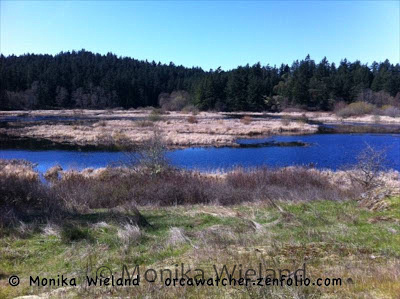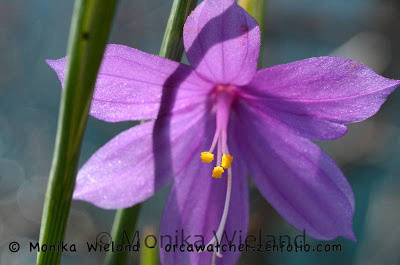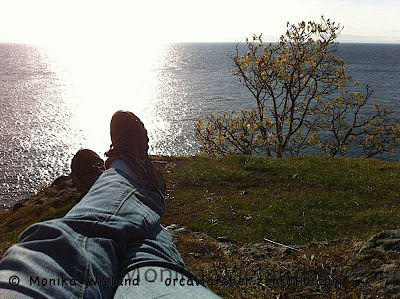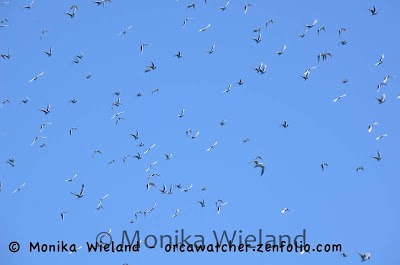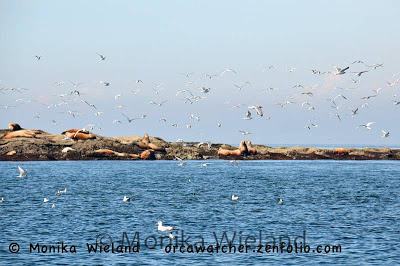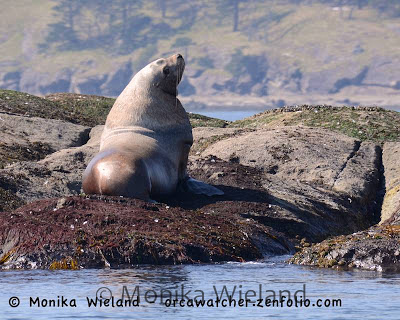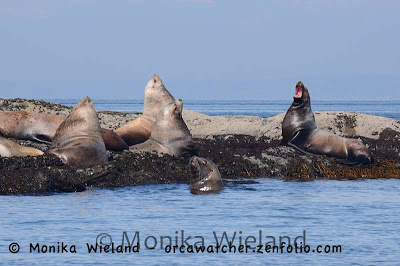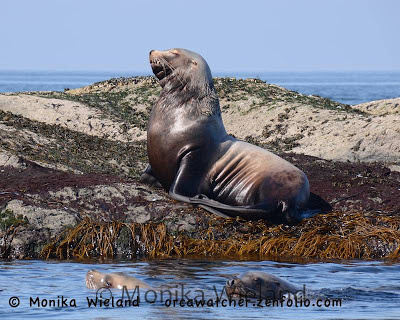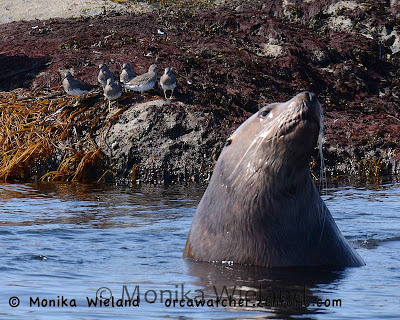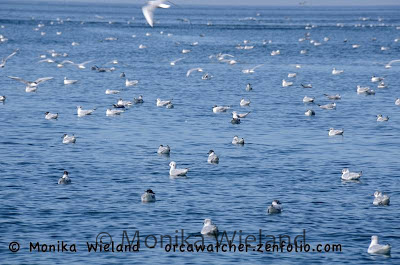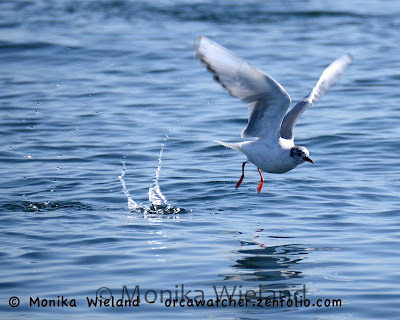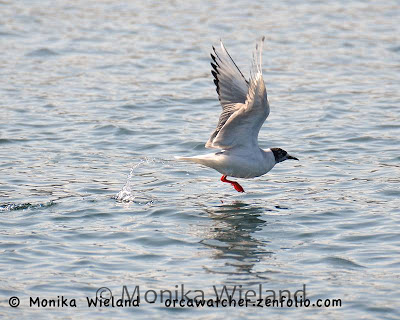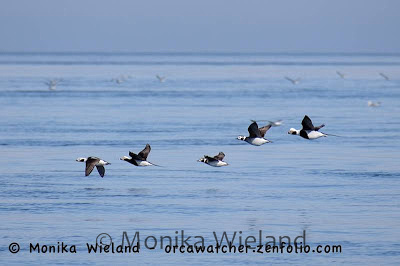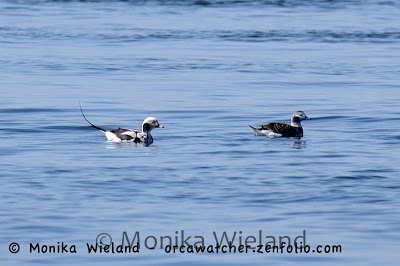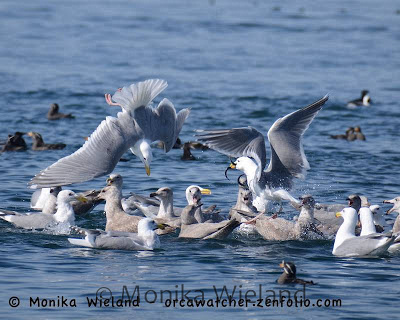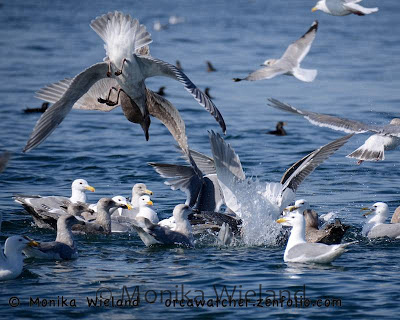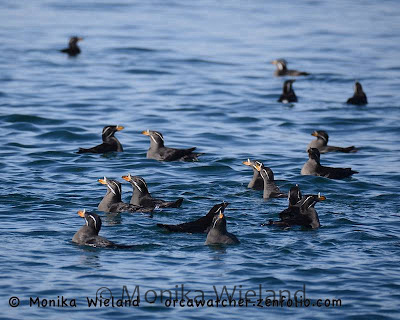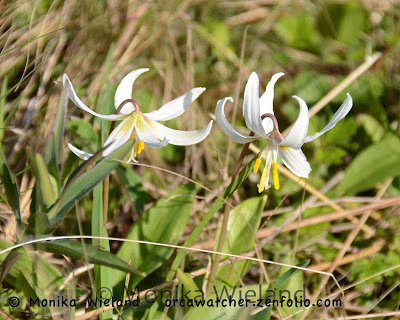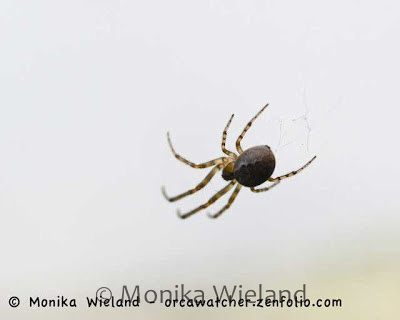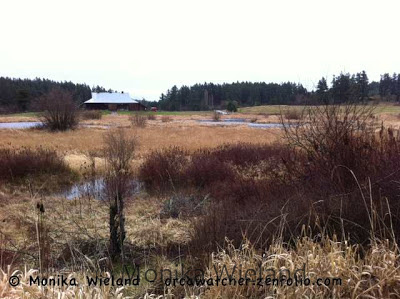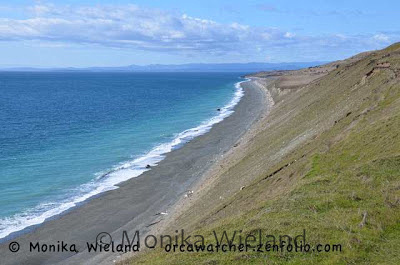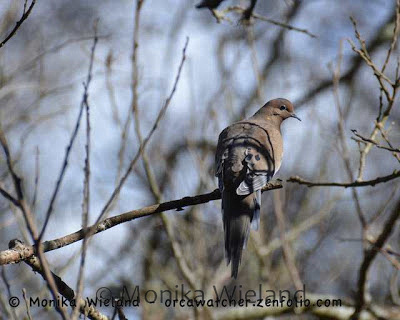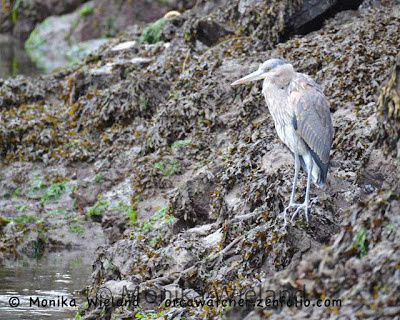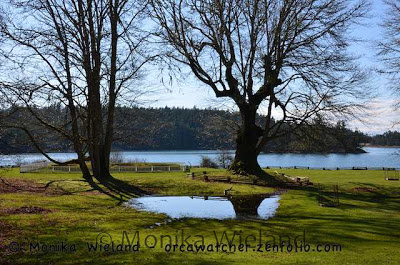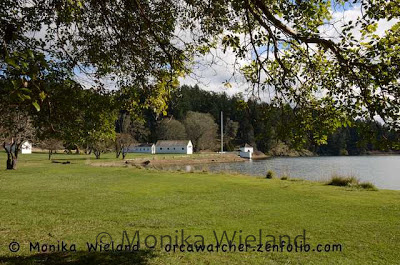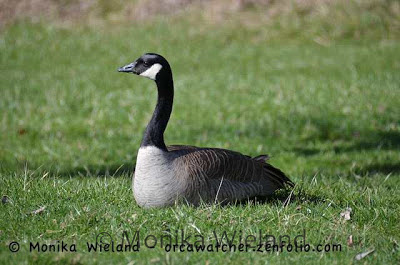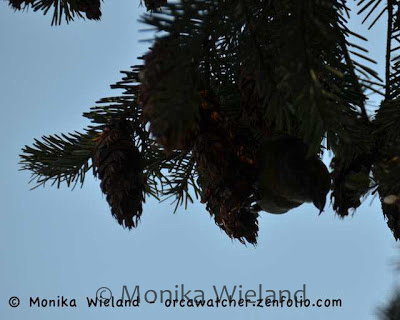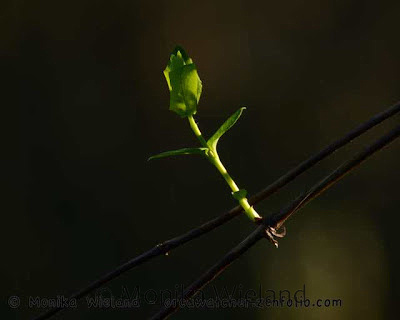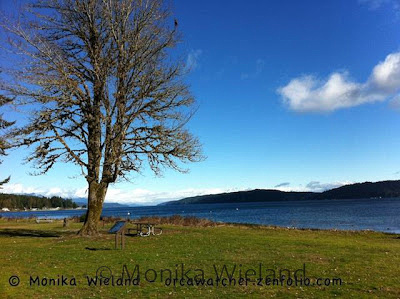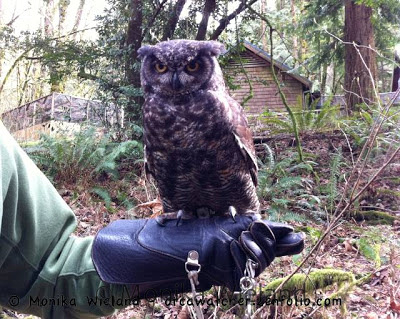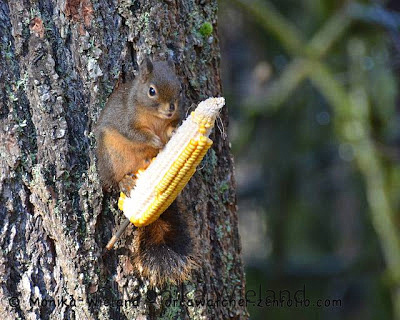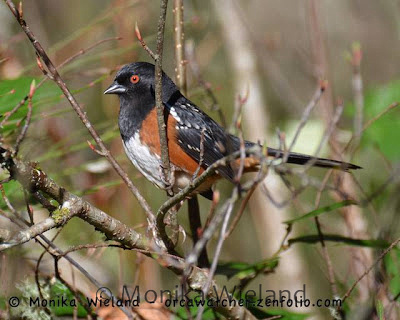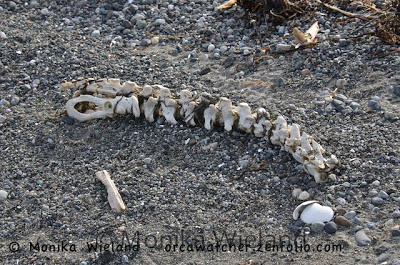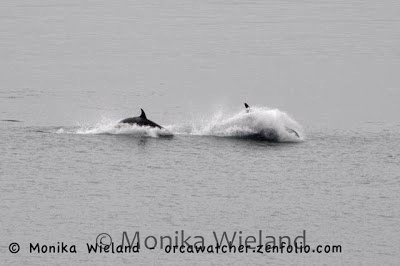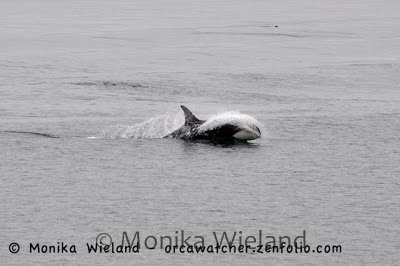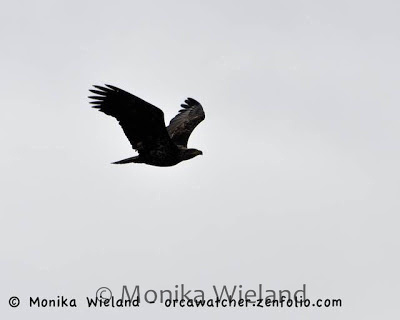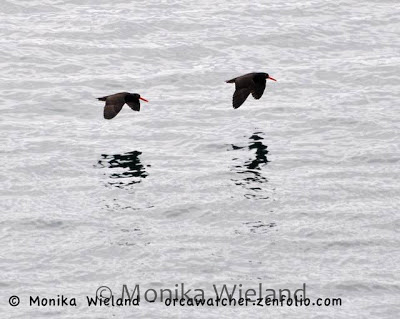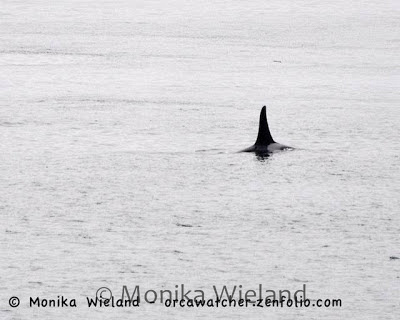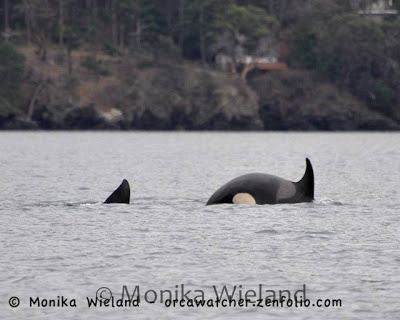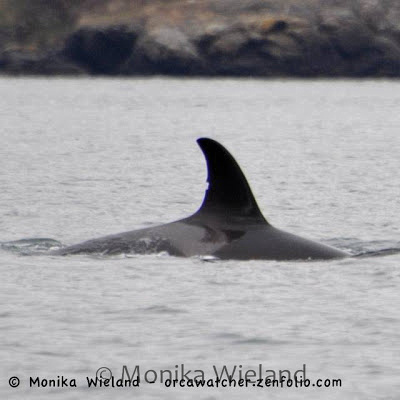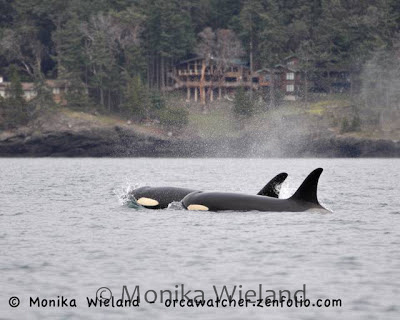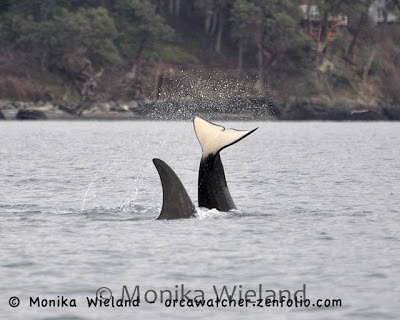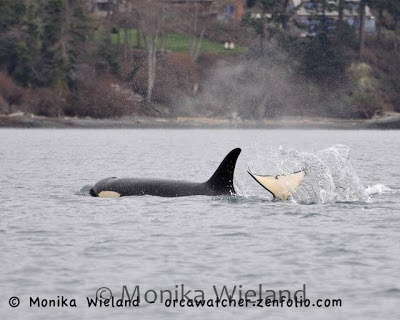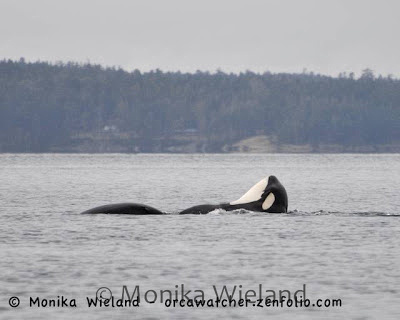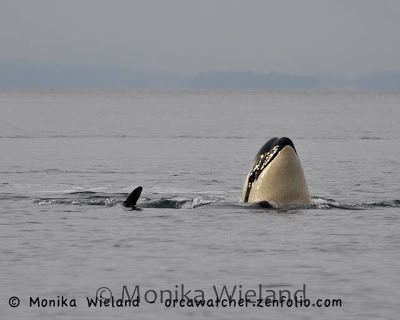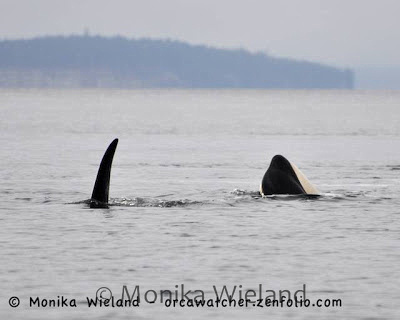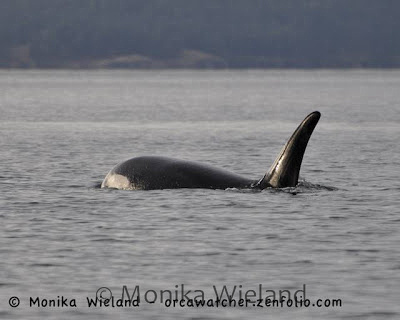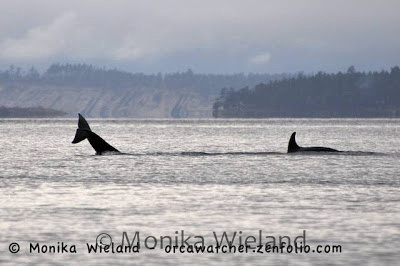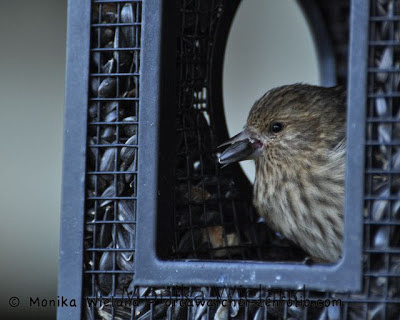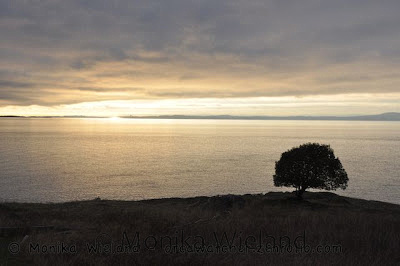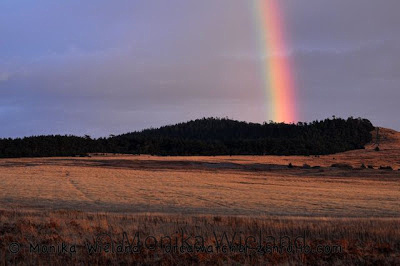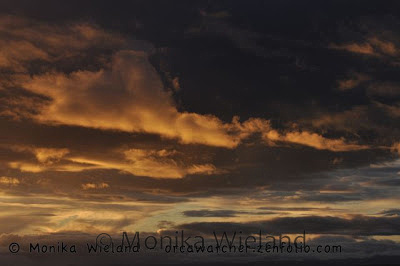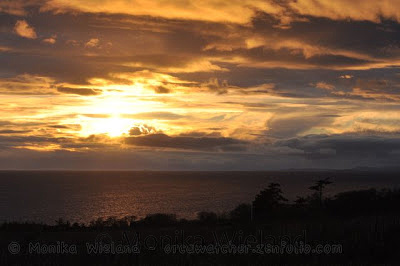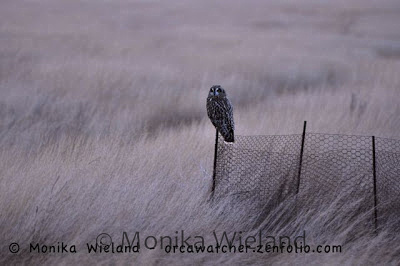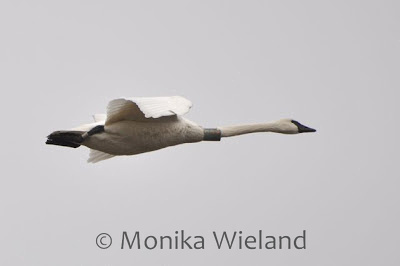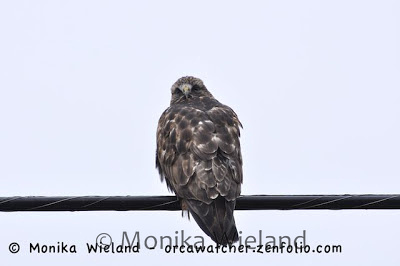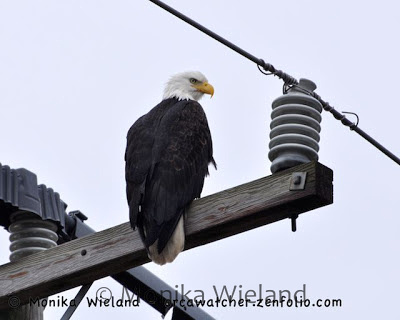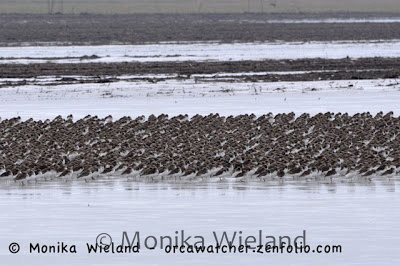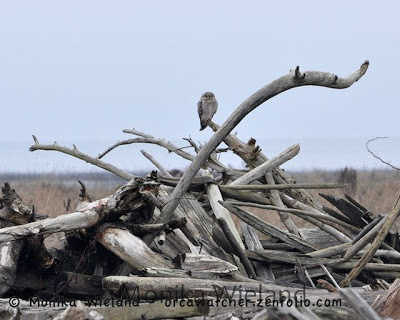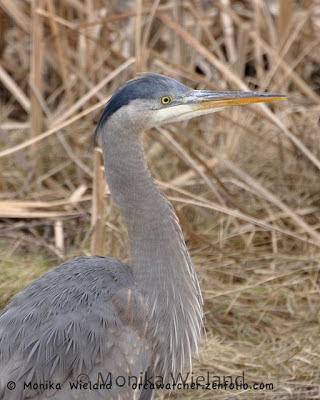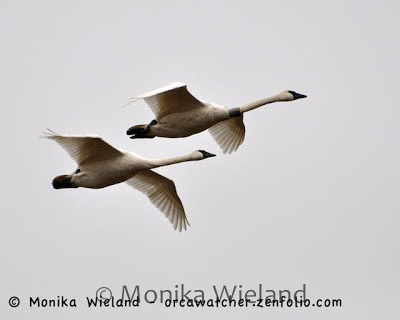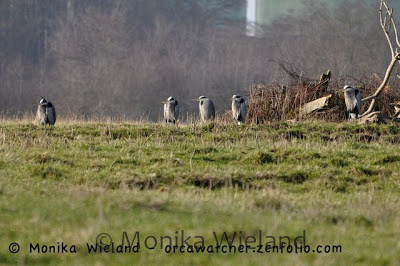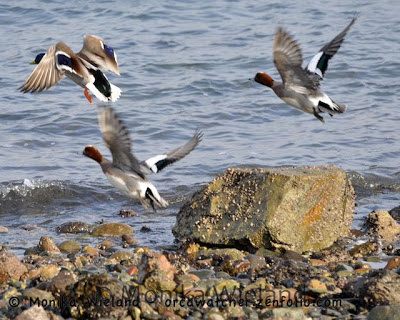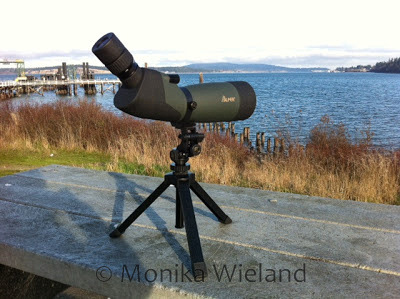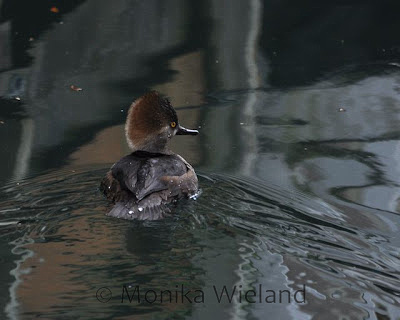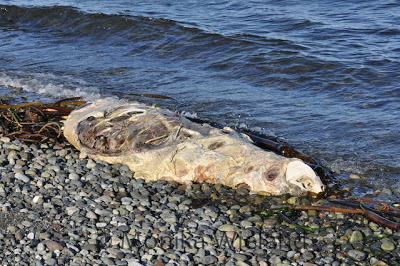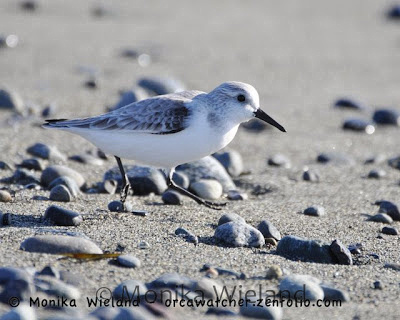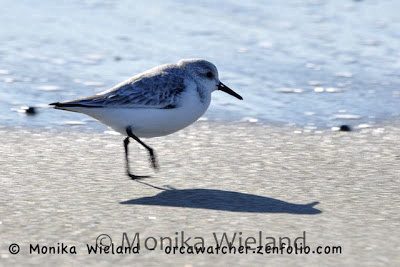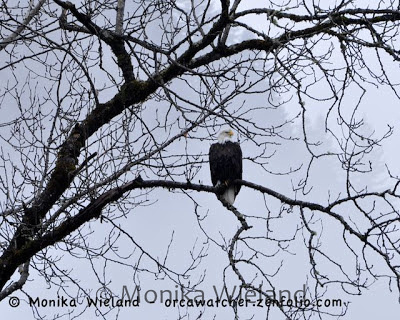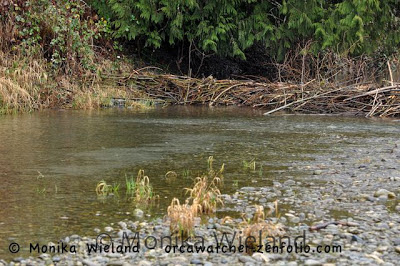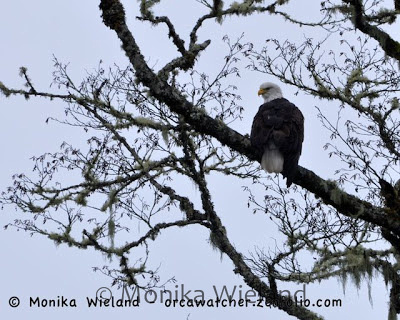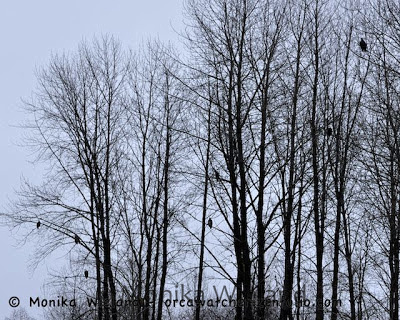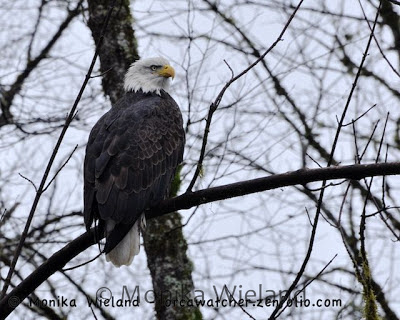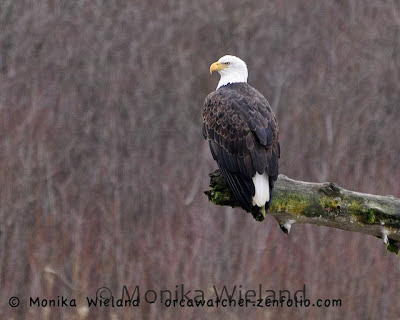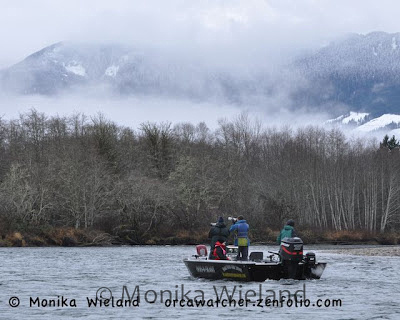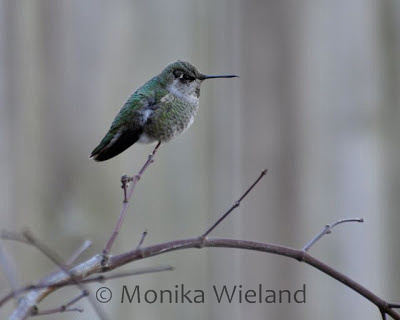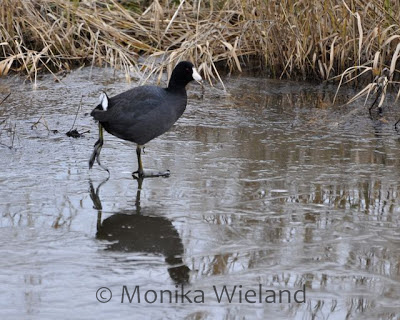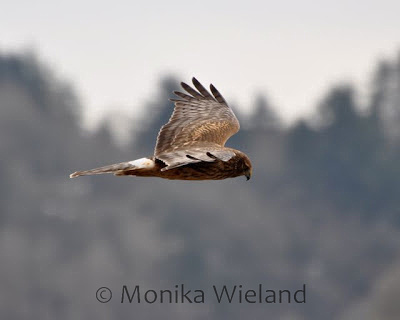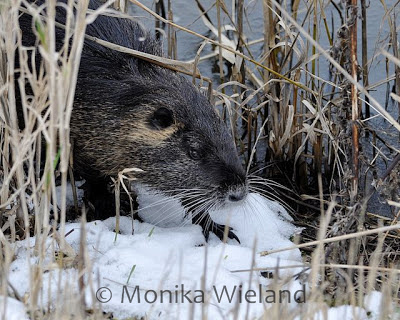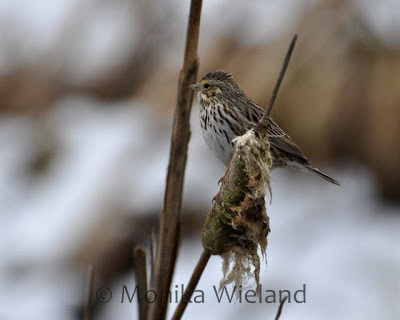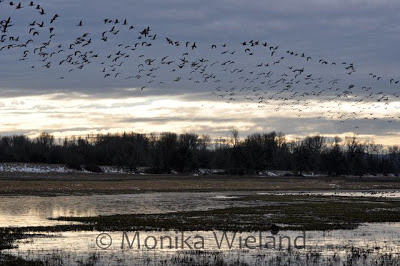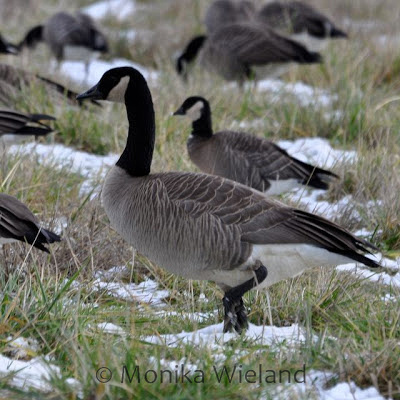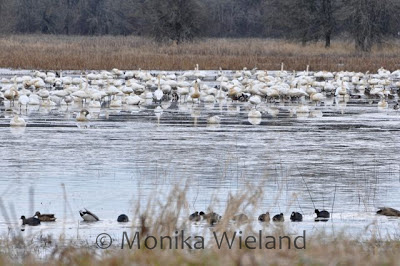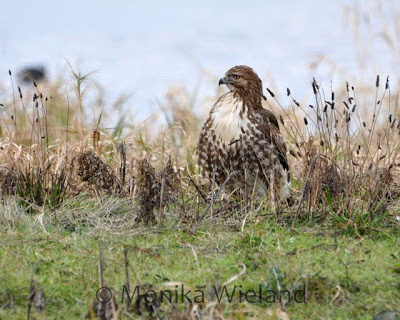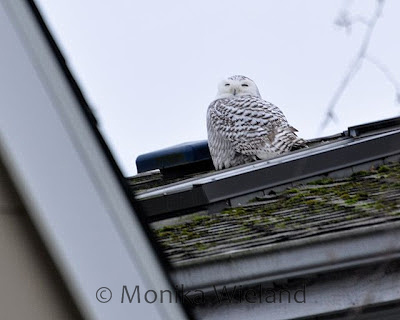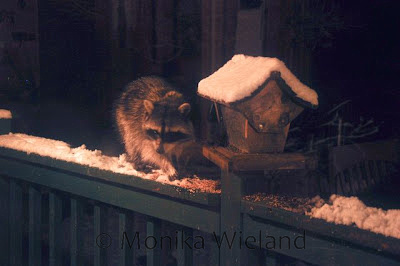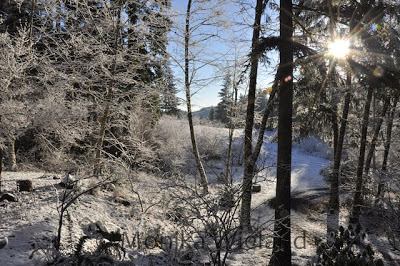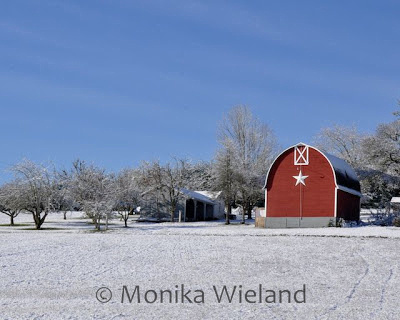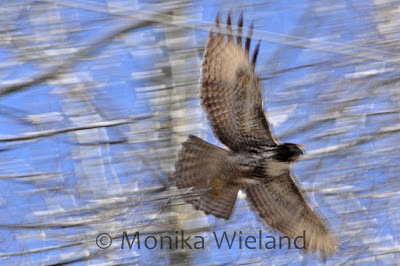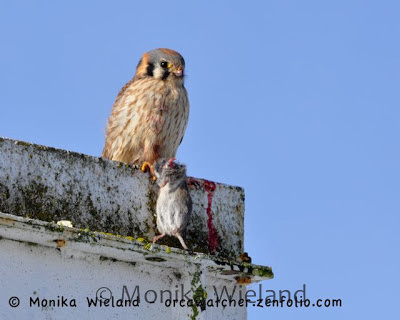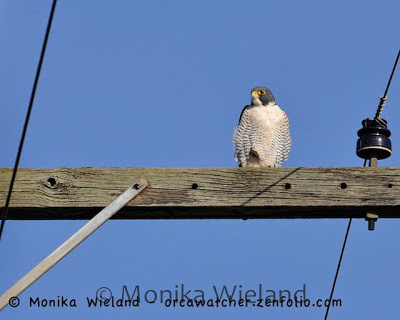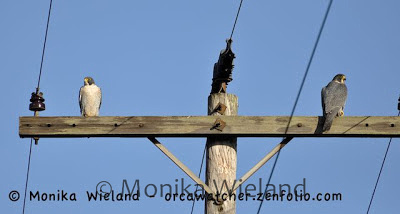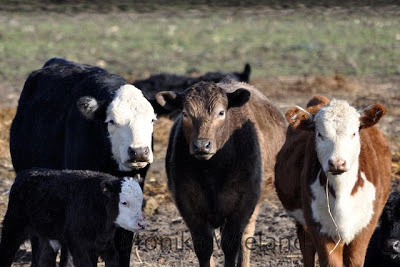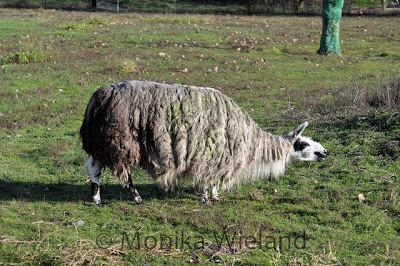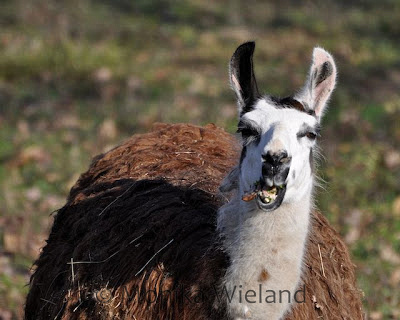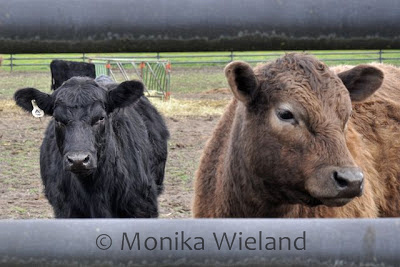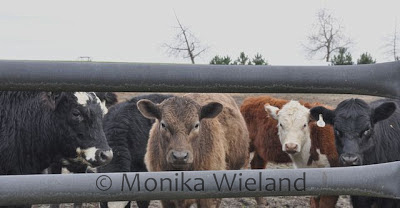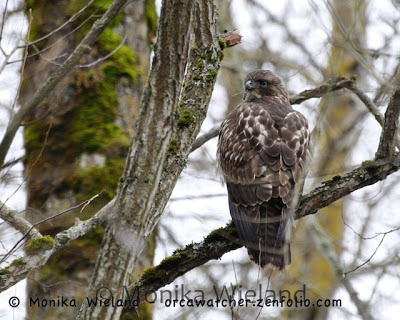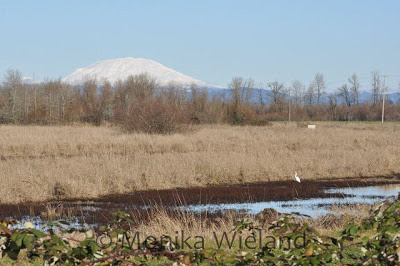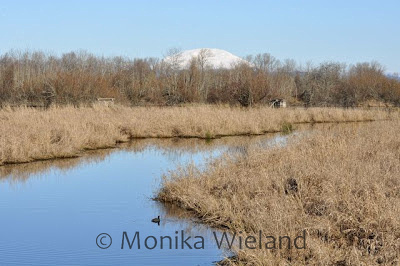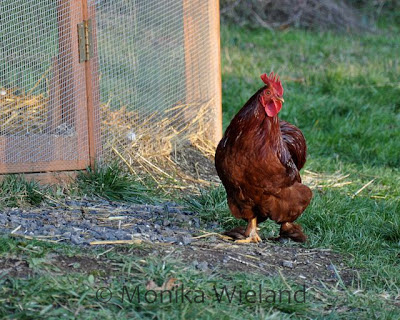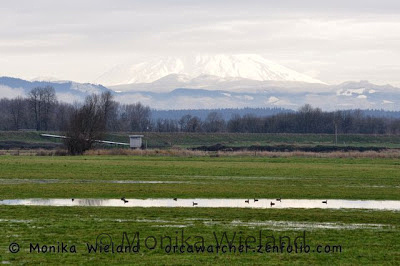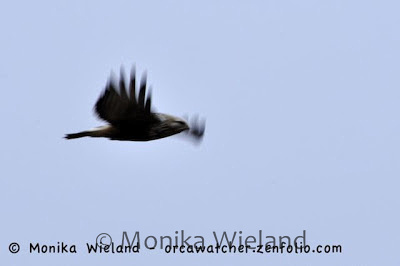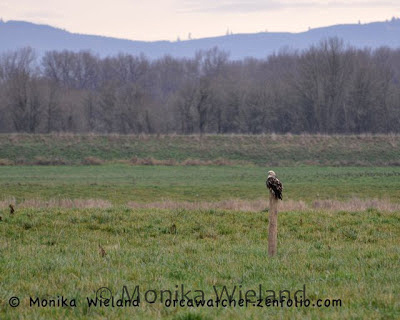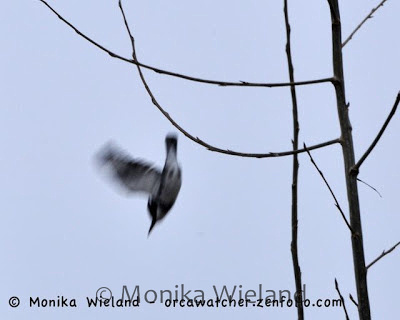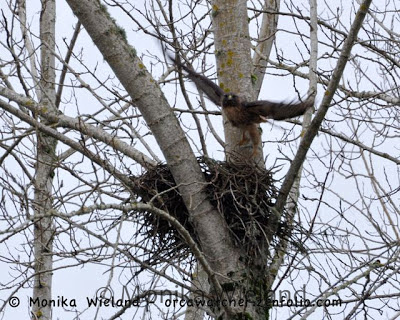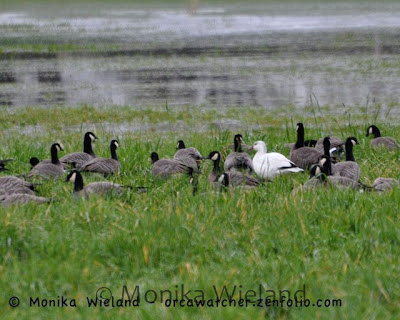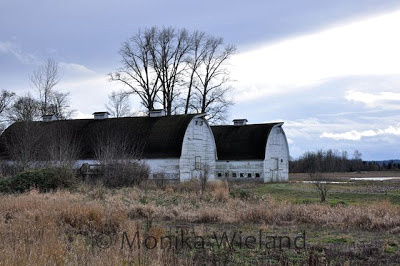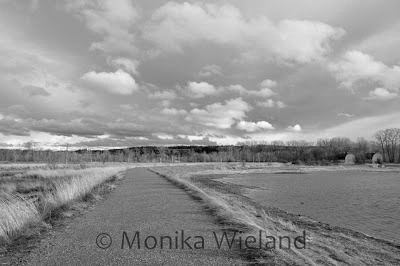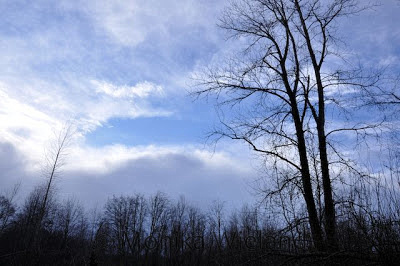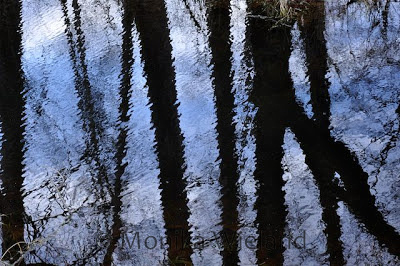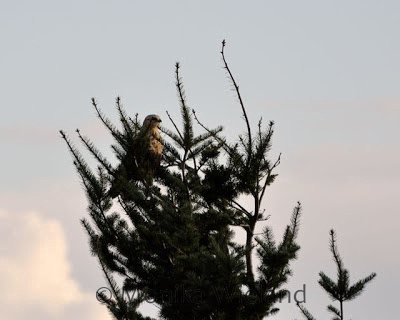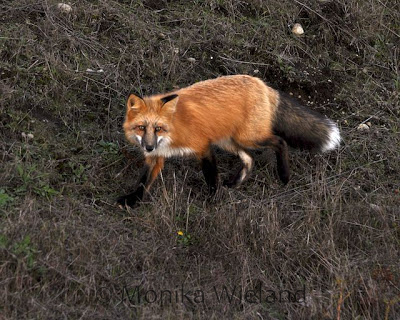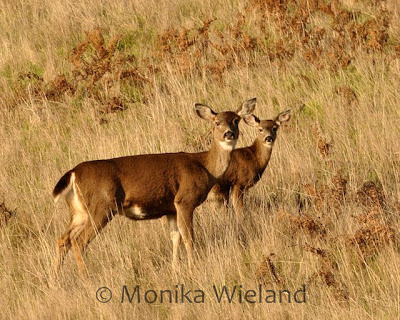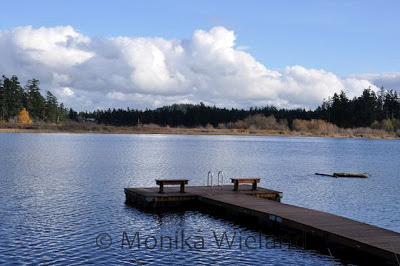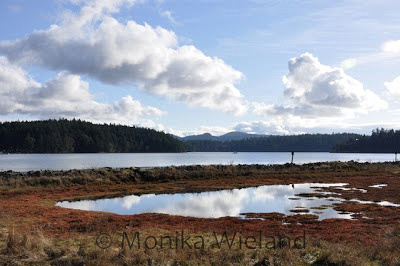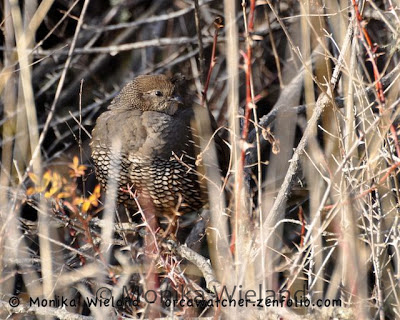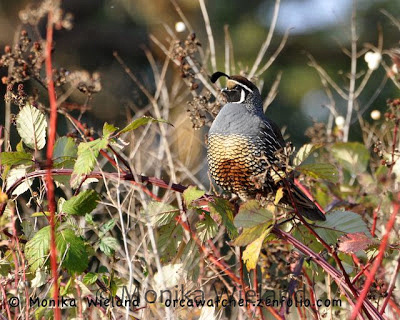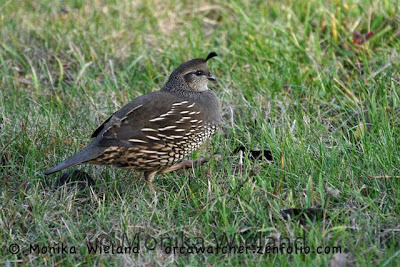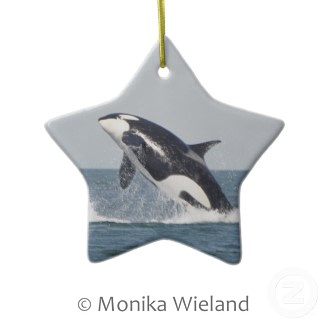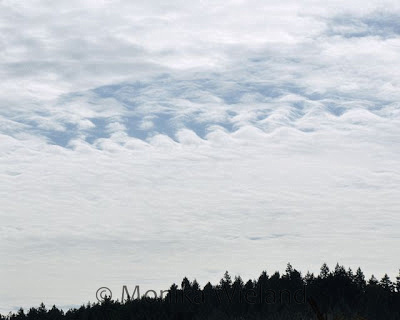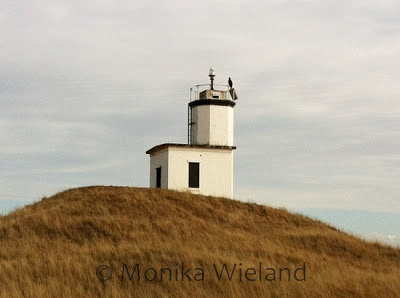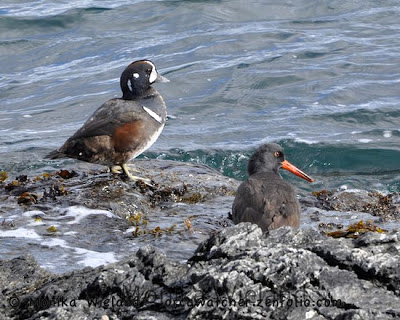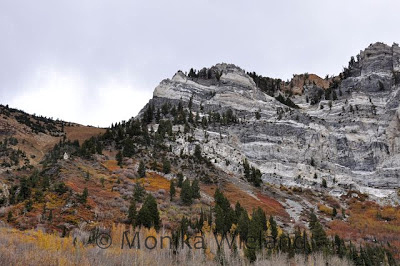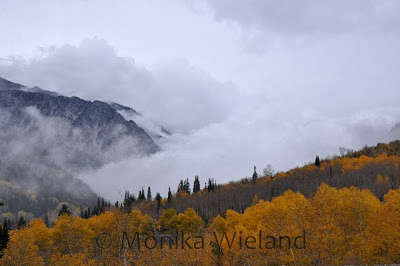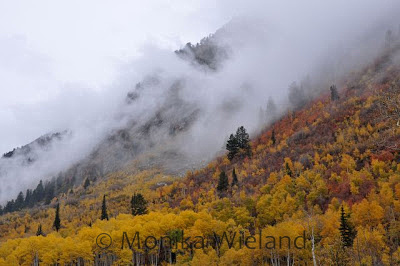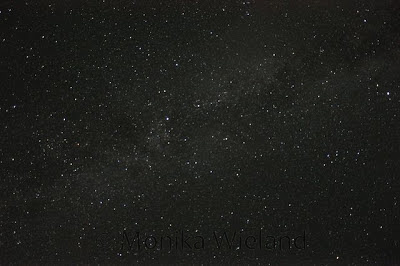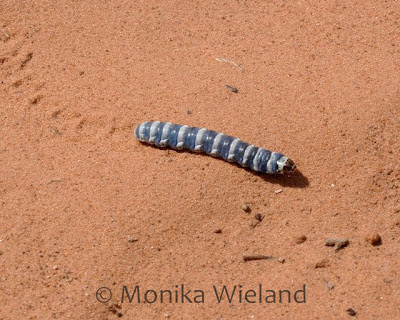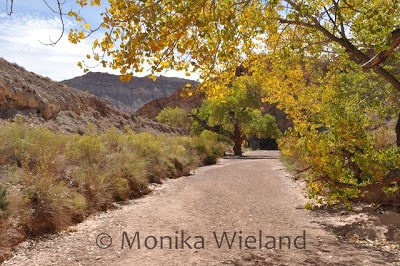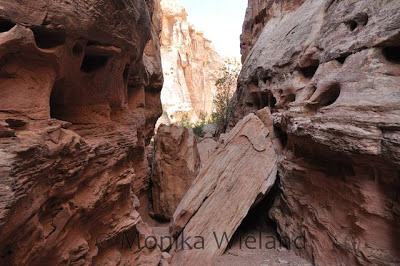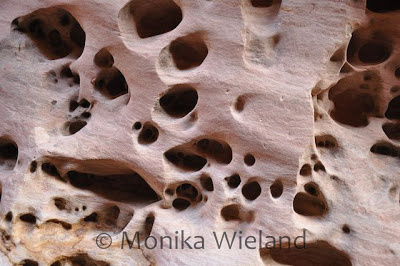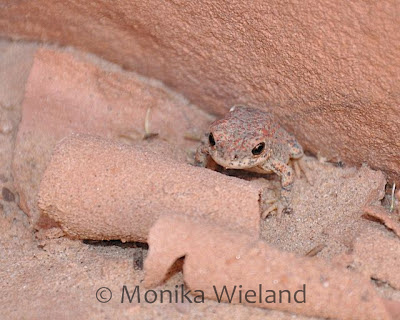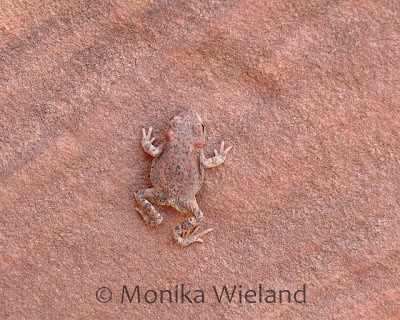A walk around Three Meadows Marsh was especially pleasant, with singing marsh wrens and red-winged blackbirds around every corner. Right when reaching the marsh I also heard a Virginia rail.
I also heard a pileated woodpecker (128), saw a pair of wood ducks (129), and spotted an early barn swallow (130) in and among the violet-green and tree swallows. It wasn't just bird life, either. I also saw three Pacific tree frogs and a garter snake.
A visit to Land Bank's Westside Preserve was more about sitting in the sun and reading, but I couldn't keep myself from picking up the camera when I spotted some wildflowers in bloom. The first one I saw was satin flower, also known as grass widows (Olsynium douglasii):
And one of my favorites, shooting star (Dodecatheon sp.):
It was a little tough to be inside at work on Monday as the nice weather persisted. I left a little early and headed straight to Land Bank again to decompress from the day, which was a great decision:
Here we are on Tuesday and it's apparent the weather is changing back to being a little grayer, cooler, and wetter again. The great bird sightings are coming in left and right, however, so I'm sure there will be some more good sightings in the near future!
]]>Yesterday at lunch I saw an album posted by my friend Traci (of Traci Walter Photography) of an amazing boat trip she took up near East Point on Saturna Island in the Canadian Gulf Islands. She saw thousands of gulls and sea birds. I sent a message to my friend Phil, another bird-watcher who like me doesn't work on a whale-watching boat and doesn't get the chance to visit some of these places all that often. He got his own boat a little over a year ago and we had talked about the potential of splitting costs to go check out some of these great sightings when they pop up. "When we going, Phil?" I asked. He responded two minutes later - "How about right now?" With the afternoon off of work that sounded perfect to me. Half an hour later we were on our way up San Juan Channel, navigating through some of the unseasonable spring fog that still remained and hoping for clear weather at East Point.
Luckily, despite even denser fog in President's Channel where we were still able to spot a few harbor porpoise, the fog did clear as we headed into the glassy calm waters of Boundary Pass. We had to get into Canadian waters before we could see the gulls, but soon they were evidence both on the water and in flight - thousands and thousands of Bonaparte's (125) and mew gulls:
Most of the birds seemed to be northeast of the point, so before we headed up there we cruised by the Boiling Reef rocks to see the harbor seals and Steller sea lions hauled out there.
It was pretty awesome to see (and hear and smell) so many sea lions:
Right before we were ready to move on I spotted a small flock of birds along the shoreline right among the sea lions. They turned out to be half a dozen surfbirds (126). Check out this shot of them just to the left of this huge sea lion!
Lucky for us, by this time the birds had moved a bit closer. I've been lucky enough one other time to see such huge congregations of birds at East Point, but at that time the thousands of Bonaparte's gulls were actively feeding and flying all over the place. Most of them were sitting on the water today, meaning every direction you looked it looked kind of like this:
It was interesting to me that the Bonaparte's and mew gulls seemed to segregate into different flocks that didn't intermix much. We'd find ourselves among one species, then the other, then the first again. Most of the Bonaparte's gulls were in transitional plumage, with some still in winter and some in full, black-hooded summer plumage. Still learning the new camera and getting the action settings right, I struggled a little bit with the in-flight shots, but got these couple of take-off shots I like:
At first it seemed like mostly just these two gull species, but if you looked closer there were other seabirds in there as well. We didn't see the thousands (!) of long-tailed ducks Traci reported, but we did see several hundred - far more than I've ever seen in one place. They seemed to be really skittish, though, and mostly we saw several dozen at a time flying in the distance. There were a few exceptions:
We came across one active bait ball that was made up mostly of glaucous-winged gulls. Unlike the long-tailed ducks, they didn't seem to mind our presence whatsoever. They had more important things to tend to. Notice the gull on the right in the first shot with some bait fish in its beak:
The bait ball was surrounded with rhinoceros auklets who we assumed were herding the fish underwater, but oddly enough we didn't see any rhinos with fish in their beaks. We ended up seeing hundreds of auklets, too, all decked out in their breeding plumage now too. Many of them were striking kind of an awkward posture with their head's raised high, maybe some kind of courting behavior?
In much smaller numbers we saw several other species, too: red-breasted mergansers, harlequin ducks, black oystercatchers, common murres, and one bald eagle.
On our way back to Friday Harbor, Phil had to make a stop at Yellow Island where he is the steward, and I was more than happy to take a quick walk around the island to check out the early spring wildflowers. Yellow Island is always several weeks ahead of San Juan Island in terms of blooms - fawn lilies were out in abundance, and I also saw some harsh paintbrush and shooting stars. Here's a pair of fawn lilies in the sunlight:
As an added bonus, I also saw my first of the year rufous hummingbird (127) while we were there!
It was a spur of the moment trip, but often those end up being the best kind. It was a beautiful afternoon on the water with some amazing wildlife. Just what I needed! Thanks Traci for the head's up, and thanks Phil for driving!
]]>Birds
Glaucous-winged gull
Belted kingfisher
Rock pigeon
Pine siskin
Dark-eyed junco
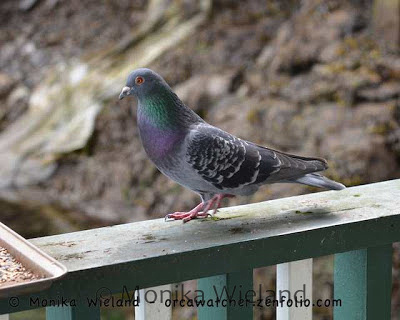
|
| Rock pigeon |
Flowering plants
Licorice fern
Two unidentified tiny, weedy species
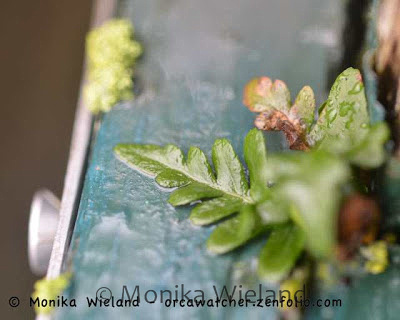
|
| Licorice fern |
Seaweeds
Bull kelp
Rockweed
Eelgrass
Sea cabbage
Seersucker kelp
At least one other type of kelp-like seaweed
At least one type of sea lettuce (Ulva spp.)
At least one type of brown tuft seaweed
At least one type of filamentous red seaweed (of which there are about 60 local species that can only be distinguished microscopically)
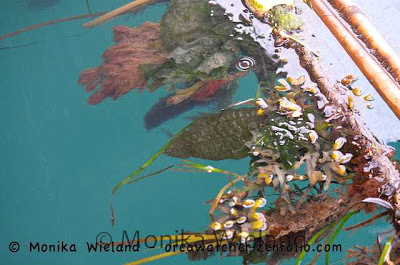
|
| Amazingly this shot shows almost all the different types of seaweed at once |
Mosses
Five species, including probably:
Juniper moss
Red bryum
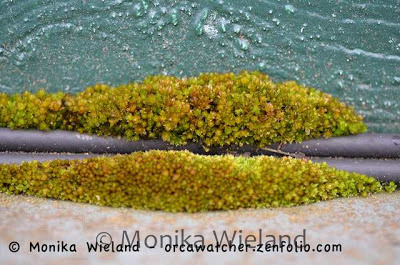
|
| Moss species |
Lichens
At least four species, including potentially:
Xantharia sp.
Hypogymnia sp.
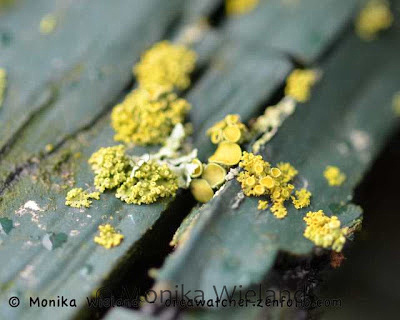
|
| Lichen species |
Arachnids
One type of orb spider
Invertebrates
Blue mussel
Acorn barnacle
California sea cucumber
Orange sea cucumber
Giant plumose anemone
Giant green anemone
Red-trumpet calcareous tubeworm
Ochre star
Monterey sea lemon (a type of nudibranch)
Graceful decorator crab
Kelp crab - perhaps Pugettia gracilis
Giant rock scallop
One shrimp species
One unknown crab-like species (see photo)
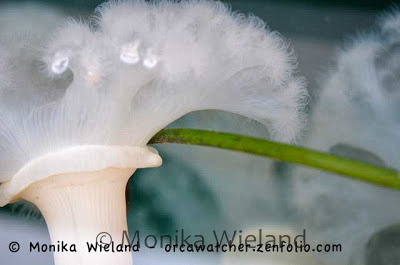
|
| Giant plumose anemone |
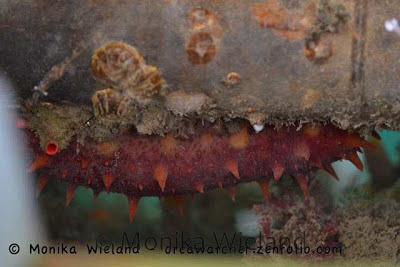
|
| California sea cucumber |
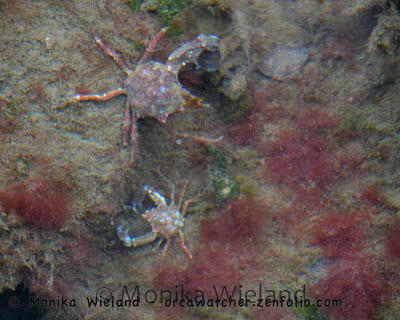
|
| Two kelp crabs, possibly graceful kelp crabs (Pugettia gracilis) |
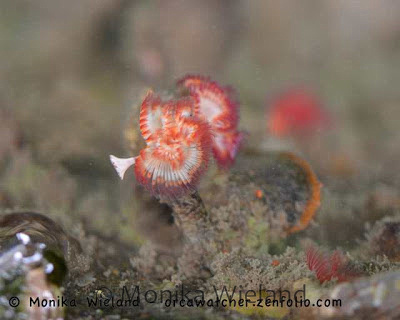
|
| The coolest find of the day, a small species with a big name that I hadn't noticed before - red-trumpet calcareous tubeworm |
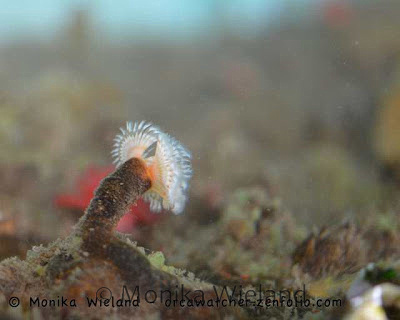
|
| Another red-trumpet calcareous tubeworm - they ranged in color from all white to all red or any level of mixed banding between the two colors |
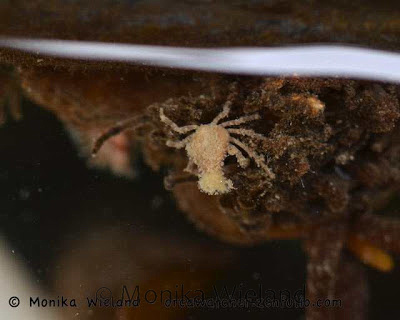
|
| The unknown crab-like species, about the size of a thumb nail. Any ideas?? |
Mammals
Mink]]>
When taking a first glance at the marsh, there weren't many (or any) bird in sight. Closer scanning with the binoculars and a walk all the way round turned up a respectable 10 species of waterfowl. The highlight of the walk, however, was hearing two or three different Virginia rails. Also heard were both marsh and Pacific wrens and a lot of red crossbills. The species total for the one hour walk was 24.
Sunday was much more what I hoped for weather-wise: sunshine! It was windy and chilly, but that didn't matter as much. I could just feel myself beginning to recover from the winter-long vitamin D deficiency as I walked along the bluffs at Cattle Point. If I just looked at the scene in front of me and ignored my partially frozen ears and fingers, I could imagine this being a tropical beach below me:
That daydream only kept me warm for a few minutes, though, so I headed to the other side of the dunes to get more out of the wind. On the windy side the only notable sighting was five bald eagles (one adult, four immature) playing in the wind. Two of the immature eagles were chasing each other around at top speed, which was awesome to watch. There were a wider variety of birds to be seen on out of the wind, however. In the trees I found a pair of mourning doves - still an uncommon species on San Juan Island, though I seem to be finding them more regularly here:
In the same clump of trees I found a small flock of bushtits (year bird 117) and hear a pair of Bewick's wrens (118) singing. A few minutes later, while scanning the channel, I got my first definitive look at a Brandt's cormorant (119) this year. I'm sure I've seen them during my other visits to Cattle Point, but they're usually too far out in the channel to see any field marks, instead ending up on my day list as "cormorant species". The species total for this outing was again 24.
During the week I didn't have a chance to get out much, but one day this very pale, scraggly looking great blue heron came for a visit right off the front porch:
It was kind of a gray week, but today, Friday, the sun came back out so this afternoon after work I went for another walk at English Camp. I was particularly hopeful to add at least one spring migrant to my year list, but alas there were no osprey building a nest, warblers singing in the treetops, or swallows cartwheeling over the bay. Patience, patience - they'll be here soon! It was a beautiful walk regardless.
There's enough different on my new camera that I still feel like I've got a lot to learn, so I played around with a few different things while aiming my lens at some of the more common species that I admittedly sometimes take for granted and don't photograph at all.
While standing at Bell Point watching five black oystercatchers in flight over the bay, I realized the Douglas fir I was standing under seemed to be crackling. Right over and around me was a small flock of red crossbills feeding on seeds out of the cones, seemingly unbothered by my near presence. Despite being so close to them, I couldn't get a very clear look at them. This is about the most of any bird that I saw - see the crossbill?
Crossbills seem to be really abundant on the island right now. They're often hard to get a good look at, but if you are familiar with their call, you can hear them everywhere. They were just one of the 26 species I saw at English Camp this afternoon.
The red-flowering currants were in bud, which means the rufous hummingbirds should be here any time now. This shot in particular reminded me that even though I'm ready for it to be here NOW, spring is indeed on the way:
Saturday morning we continued down the Olympic Peninsula, making a couple of stops to look for birds and take in the surprising sunshine. Here at Potlatch State Park, we saw both common and Barrow's goldeneye (113) as well as wigeon, surf scoters, and common mergansers:
We got into Portland just in time to go to the hockey game we had tickets for and parked in our usual spot. Unfortunately, while we were there, my car got broken into, and a whole bunch of stuff got stolen, including my binoculars, camera gear, laptop, and new scope. We're still fighting the insurance battle, as they right now don't want to cover any of it, and in the meantime still recovering from the shock of losing so much coming to terms with the fact that people do that kind of thing to one another. Thankfully, pretty much everything that was taken was replaceable. For example, all but my last week's worth of photos were backed up at home, and nothing too personal was lost. It was a stark reminder of what's really important in life: it was, after all, just stuff.
Our weekend turned into a quite different one than we had expected, and we decided to take advantage of being in Portland to replace some of the things it would be hard to get on the island. It's taken a while to get back up and running which is why there's been such a gap in the blog postings. Obviously, I wasn't going to be happy for very long without a computer, camera, or binoculars, so we went about replacing those. We went to the Portland Audubon Society to replace the binoculars, and while there walked one of their trails where we ran into this lovely lady. I'm still looking for a wild great horned owl to add to the year list, but it was pretty cool to see her up close. She's unable to live in the wild and is kept there as an educational bird:
On the way back out to St. Helens we stopped at the Crown-Zellerbach Trail to do some more birding. It was the best part of the weekend. We saw nearly 40 species including a couple American bitterns (114) and a merlin (115).
On the plus side, if there is one at all, I got a slight upgrade to my camera and lenses. Here is the first picture I took with my new D7000. It's a similar camera body to the D90 I had but features some nice upgrades such as faster focusing and rapid-fire shooting, a weather proof body, and dual SD card ports:
Here's one of the next pictures I took while testing things out in my parents' yard:
While out and about playing with the new camera, I also saw a single band-tailed pigeon (116). It was an active morning in the yard with evening grosbeaks, chestnut-backed chickadees, dark-eyed juncos, Pacific wrens, and song sparrows out and about, too.
We headed back to San Juan Island a day later than planned and again had sunny weather for the trip back up. It was a bit dream-like to return to the small island community. While we do have crime here occasionally, it's a much more relaxed and trusting atmosphere. Here's a shot from the Anacortes ferry landing looking over towards Mt. Baker near sunset:
This weekend I got a chance to get out a little bit, and though the weather was fairly clear on Saturday, it was pretty windy, and as a result there wasn't much bird activity on the south end of the island. I did a bird survey at Fourth of July Beach, where as usual I didn't find any stranded sea birds, but I did see some remnants of the stranded pinniped I found there during my last survey:
Next up, there's nothing to do but move forward. The plan is to learn the ins and outs of the new camera and post some more test shots here soon!
]]>All Saturday plans quickly went out the window with an early morning head's up from my friend Katie that J-Pod was seen heading towards San Juan Island. I quickly got my gear together and headed out to the westside of San Juan Island where I met up with Katie and some other hopeful whale watchers at Land Bank's Westside Preserve. We spent well over an hour scanning the flat calm waters for whales with no luck. I was getting cold and was just about ready to pack it in when the Center for Whale Research boat came into view. We heard they didn't know exactly where the whales had ended up after being spotted more than two hours ago, but they were out to look. I decided to hang around and see if they would find them. A little while later, I saw them slowly motoring towards us from across the Strait and lifted my bincoulars. Next to them appeared one, then two, then three dorsal fins. They had found them! Staying was the right decision.
It turned out to be Group B of J-Pod (J11s, J17s, and J22s) and they very slowly made their way towards San Juan Island. The question is always which way they'll go when they hit shore (north or south), and luckily they chose north, towards us. The whales were all taking very long dives so there were long stretches of not seeing anything, but then they would pop again, very slightly closer to us than they were before. J17 Princess Angeline was in the lead, with her offspring and grand-offpsring behind her. The action started to pick up when a freighter came by, and the whales decided to briefly surf in the freighter wake. So cool!
The J17s continued north and were hanging out just offshore of Lime Kiln and we waited for the next small group of whales to approach us. In the meantime, there were plenty of other things to point the camera at, like this immature bald eagle, and the following pair of black oystercatchers:
J34 Doublestuf was the next whale to approach, and he spent a long time foraging right offshore from where we were standing. He never made it too close to shore, but I wanted to document how much his fin has grown over the winter:
By now I had been outside for about four hours and needed to warm up and get something to eat. I headed back into town with the heat blasting in the car when I got a message from another friend and fellow naturalist JB that since the whales had finally made it north of the lighthouse he was going to take his boat out for a little bit and did I want to go with them? I hadn't even made it home yet, but the answer was definitely yes! I raced out to Snug Harbor to hop aboard Wavewalker with JB and two other whale lovers, all of us with cameras in hand.
I got even colder and hungrier for the hour and 45 minutes we were on the water, but I am SO glad I went. What followed was a very peaceful and playful whale encounter, where for most of the time we were the only boat with the whales. The group we were with was made up of all the J17s, plus J31 Tsuchi, J22 Oreo, J32 Rhapsody, and possibly J38 Cookie. All "the boys" were apparently elsewhere - J27 Blackberry, J34 Doublestuf, and J39 Mako.
The first whale we saw was J17, who was still off by herself ahead of the other whales. We headed towards the bigger group a little ways behind her. They were still very slowly moving north and going on some long dives, but in between times underwater they were hanging at the surface in a very roly-poly tight group. We had a lot of time like this one, with lots of animals hanging at the surface and a head or two poking out of the water. That's Lime Kiln Lighthouse in the distance:
The other thing we heard a lot of was above water vocalizations. Orcas emit sounds through their melons (foreheads), and when they're hanging at the surface like this if they're vocalizing it can be heard in the air. Occasionally you'll hear one or two calls or a whale blowing a "raspberry", but on this day it was happening all over the place! We had heard it from shore in the morning and even more on the water in the afternoon. It was amazing to even be able to ID the call types they were using: S1, S2, S33...
(The most amazing above water vocalization incident I've ever witnessed, back in 2004, is documented here.)
The J17 family group is made up of: matriarch J17 Princess Angeline, her adult daughters J28 Polaris and J35 Talequah, her young son J44 Moby, and the first calf of Polaris (J46 Star) and Talequah (J47 Notch). So there's three adult females and three calves under the age of four, and it was fun to just hang out with this family group. As mentioned above, J31 Tsuchi, J22 Oreo, and J32 Rhapsody, all other adult females, were hanging out with them. It seemed like the whales were enjoying some quality time with each other, pushing each other around and playing with the kids. Tsuchi and Rhapsody are also of calf-bearing age but have not ever been seen with a calf. They spend a lot of time with these moms and youngsters, perhaps learning how to be a good mom!
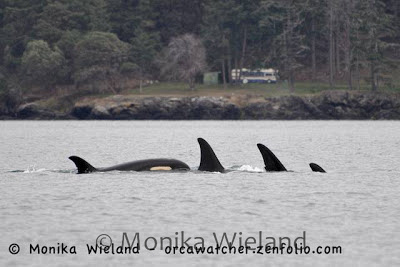
|
| From left to right: J47 Notch, J35 Talequah, J28 Polaris, and J46 Star |
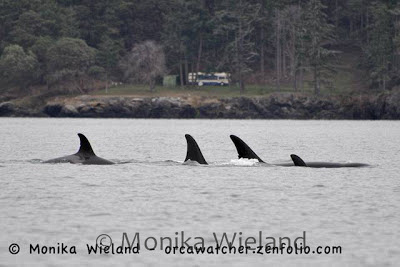
|
| From left to right: J47 Notch, J35 Talequah, J28 Polaris, and J46 Star |
Young J47 Notch is distinct not only for the notch in his fin that is his namesake, but he has a pretty cool saddle patch too. Here's a cropped close up of him from the above photo:
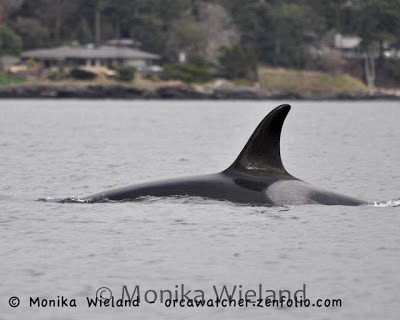
|
| J35 Talequah |
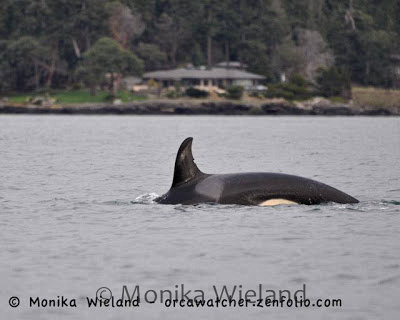
|
| J47 Notch |
After seemingly spending the day mostly by herself (maybe she needed some "me" time away from the boisterous kids), J17 Princess Angeline came back over to rejoin her family group, and her son J44 Moby immediately returned to her side after spending the day playing with his niece and nephew (who are about the same age as him).
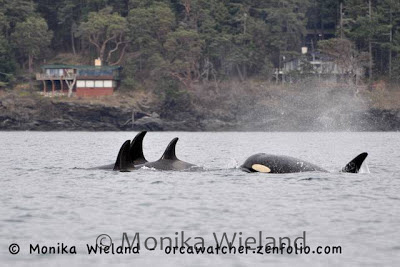
|
| From left to right: one whale diving, then J17 Princess Angeline, J44 Moby, and J28 Polaris |
When the whales were at the surface, we saw bouts of different surface behavior, including spyhops, pec slaps, tail slaps, and a few tail waves or headstands:
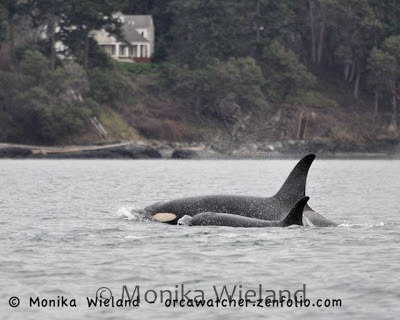
|
| J31 Tsuchi with one of the kids |
You're not getting tired of so many photos in this blog post, are you? I hope not! I wasn't getting tired of taking them:
J46 Star is a special whale to me because I was there the first time she was ever seen in November of 2011. You can see some photos of her as a newborn here. Now she's three years and three months old, but still traveling right next to mama:
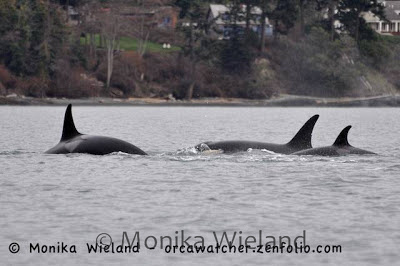
|
| J35 Talequah, J28 Polaris, and J46 Star |

|
| From left to right: J31 Tsuchi, J32 Rhapsody, J28 Polaris, J46 Star |
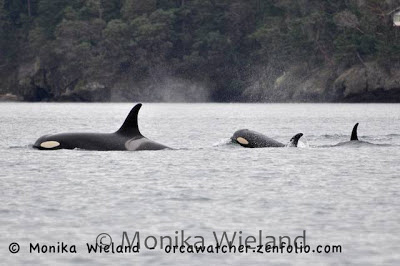
|
| J17 Princess Angeline and J44 Moby |
Luckily the whales were taking us back towards Snug Harbor, so we got to maximize our time with them. JB had to be back in at a certain time, but we kept begging him for just a few more minutes. It wasn't hard to convince him - how you can leave with this going on all around you?
We got our last look as the sun was just peeking out below the cloud cover, making for some neat lighting to end the day:
This was my last shot of the day - and if I can anthropomorphize for a bit, it was like the whales were waving goodbye. Until when? This time of year, we never know!
I ended up being outside for seven hours, and while I didn't feel it while I was with the whales (you never do) I was frozen to my core and very hungry! I also hadn't gotten anything done I was supposed to during the day. Was it worth it? Hands down, you bet! Not only was a great pick-me-up to hang out with the whales all day, it was great to catch up with all the local whale watchers, too. Everyone seemed to come out of the woodwork to enjoy this special winter visit from the Southern Residents. So nice of them to come see us on a Saturday!
There was some good waterfowl activity at Jackson Beach, with green-winged teal, mallards, gadwall, hooded and red-breasted mergansers, bufflehead, and common goldeneye. Here in the neighborhood there have been a pair of bald eagles regularly flying over Brown Island just across the way. I've also gotten a few brief glimpses of some other more uncommon species including a sharp-shinned hawk chasing a flicker, a hardy Anna's hummingbird who is spending the winter here, and a single varied thrush.
I've also gone out owling a couple of times where friends of mine have reported seeing and hearing owls, but no such luck there. It seems I'm rarely successful when I go out specifically looking for owls, at least at night - I just have to wait patiently for them to come to me!
Yesterday the sun was out for a bit and there was word whales had been seen on the west side of San Juan Island, so we went out for a late afternoon walk. Unfortunately the sun disappeared behind the clouds as we headed out there, and the chilly breeze picked up a little bit. It was very quiet out there - no whales, and very few birds - but it was still a pleasant walk. It turned into a subtle, but pretty, sunset:
I'm keen to have my first whale sighting of 2013, but in the meantime I've been following with interest the track of K25 Scoter who was satellite tagged in Puget Sound in late December. The tag is still transmitting, and he (along with the rest of K-Pod, presumably) has gone all the way to central California and back, and is now going up and down along the Washington and Oregon Coasts. You can see the series of tracking maps and get some more information about the tagging project here.
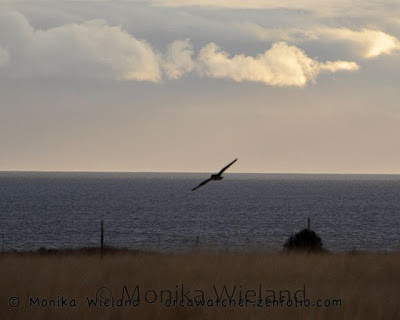
|
| Short-eared owl at dusk |
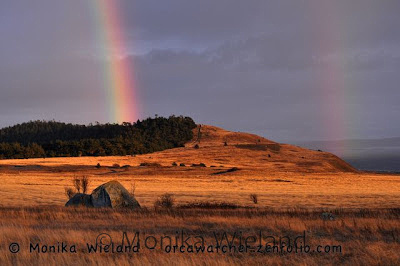
|
| Double rainbow over the American Camp prairies |
Before I left I drove down Pickett's Lane, and saw my closest short-eared owl of the day. It was almost getting too dark for photos, but not quite:
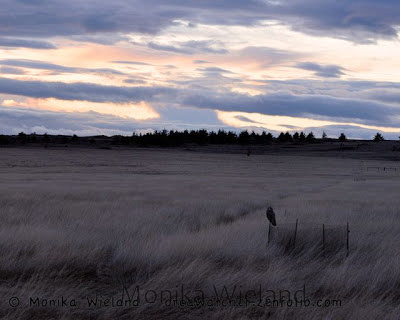
|
| Short-eared owl and the end of the sunset |
It ended up being a much better outing than I had hoped for: four short-eared owls, amazing light, beautiful sunset, and two rainbows! Can't ask for much more than that.
]]>Also, I heard back from the USGS about the banded swan I saw on Fir Island last weekend:
This bird, a male, was banded as an adult in August of 2006, meaning he's at least eight years old. The average life span for wild swans is about 12 years. He was tagged 55 miles northwest of Galena, Alaska, a distance of over 1700 miles from Fir Island. It's pretty amazing to think of far he's flown in his lifetime! It's always so neat to take small part in such research by reporting a sighting and learning part of the life history of a particular animal I saw.
]]>With some great birding reports coming in from nearby Skagit County, I decided to get off island today to see what I could turn up on the Skagit Flats. It's known for being great this time of year for raptors, and today did not disappoint. As I drove up Bayview-Edison Road, I had to stop repeatedly to take in great looks of red-tailed hawks, bald eagles, and rough-legged hawks.
By the end of the day, I estimated I had seen close to 50 eagles. This was my best view:
With temperatures still hovering in the low 30s during the day, there's a lot of frozen standing water in the regional farmlands. These dunlin (106) were all standing on ice, many of them on one leg, mostly with their beaks tucked under a wing. It was pretty comical to see a few of them reshuffling by hopping on one foot, not even fully raising their heads. This is the biggest flock of shorebirds I've seen in a long time - a conservative estimate I made at the time was 2000 birds. If this photo shows about a quarter of the flock, I figure there may have been well more than that:
I went up to a WDFW property on Samish Island Road known as West 90, where some of the recent amazing bird reports have been coming from. About a week ago someone reported standing in one spot and scanning and seeing about 40 short-eared owls! A long-eared owl, a potential life bird for me, has also made numerous appearances. This was one of my main reasons for going off island, and when I excitedly got out of the car and scanned I saw....not a single owl! What! There were multiple northern harriers flying around as well as more red-tails, eagles, and rough-leggeds. Determined, I put on my rubber boots and tromped across the partially frozen mud, which yielded one short glimpse of a short-eared owl (107), but it really wasn't at all what I expected. Is it possible I just have absolutely no idea what a sitting short-eared owl looks like?
Not all was lost on my walk out in the marsh, as in addition to the owl I saw a lot of western meadowlarks (108). The Skagit Flats are an interesting area to bird this time of year, not just because of the wide variety of bird life, but because the best birding season coincides with hunting season. As I walked out at West 90, I was following behind a camouflaged hunter shouldering a rifle, his black lab bounding through the tall grasses and leaping back and forth over a water-filled ditch. Every so often throughout the day I would detect distant movement, raise my binoculars, and find instead of a bird a human crouched in the bushes. There are a lot of people out there looking to shoot birds - some with guns, others with cameras.
Still hankering for a better owl sighting, I took off for Fir Island. Rawlins Road didn't disappoint, where I found two more short-eared owls, one of them close enough to photograph:
While watching the owl a great blue heron flew up and landed near me:
I did another loop around Fir Island after that, in part to look for a gyrfalcon that had been found. No luck there, but there were lots of trumpeter swans and snow geese to be seen. These two trumpeter swans flew right overhead:
I noticed the one on the right was banded with both a neck band and, upon closer inspection of the photo, a silver leg band. I did a little research online when I got home, and I believe the number on the neck band indicates that this bird was banded in Alaska in the north-central or northwest Arctic region. That's at a minimum over 1500 miles away.
As I made my way back towards Anacortes, I drove the March Point loop. I did a double take when I saw all these herons in a field together. I've seen herons roosting or nesting in trees in groups, but never gathering on the ground like this. There were three or four more nearby that aren't in this shot:
Despite the frozen standing water, there were still lots of waterfowl out on the bay. I saw hundreds and hundreds of American wigeon and northern pintail, a good number of mallards, and smaller numbers of common goldeneye, green-winged teal, and bufflehead. The best sighting was not one but two Eurasian wigeon hanging out right together:
Then, on somewhat of a whim, I decided it was time for me to bird in style, and I splurged on a spotting scope from Anacortes Telescope. I tried it out on its mini tri-pod at the Anacortes ferry terminal while waiting for my ride home:
It's niiiiice. Tomorrow I may just have to try it out here on the island and see if I can pick myself up a long-tailed duck off the south end.
The ferry ride back to Friday Harbor was beautiful. In addition to seeing more bald eagles, all three merganser species, a nice group of common goldeneye, and some various alcids, the lighting was stunning as the evening neared sunset. The sun was behind an island, but the bright golden light made the clouds above it look like they were on fire, complete with a dark trail of smoky gray clouds above. Much of the rest of the sky was a deep lavender, with a few misty low-hanging clouds looking like they were illuminated bright pink from within. I was just sitting and taking it all in rather than taking any photos, so you're going to have to picture this one for yourselves!
]]>Friday afternoon we headed towards the south end of the island and the first bird I saw was the rough-legged hawk hanging out between American Camp and South Beach. Seems like he/she has decided to spend the winter here, as for the last month or so it's been within the same half mile or so. It's nice to see it so regularly here on the island.
I had added northwestern crow (88) during the week and the first year bird of the outing was a sharp-shinned hawk (89) flying over the road. At South Beach, there weren't very many birds out in the strait, but there were a nice variety of species represented, so I also added common loon (90), surf scoter (91), and Pacific loon (92) there. There were some very far away birds that might have been long-tailed ducks, but with the distance and lighting it was just too hard to tell for sure.
Things were fairly quiet bird-wise at Cattle Point, too. It was pretty breezy so maybe most were taking refuge from the icy temperatures somewhere else. It was just so nice to see some sunshine after days of dark and gray!!
Among the bufflehead in the pass were some harlequin ducks (93), and while we were watching them a pair of black oystercatchers (94) flew by. While scanning the gulls and cormorants over on Goose Island I also spotted a pair of black turnstones (95). There were some alcids out in the middle of the channel, too.....hmmm...pigeon guillemots still in winter plumage and....please come a little closer.....yes!! Ancient murrelets (96).
There have been some nice birds visiting at home, too. A flock of about thirty pine siskins has been regularly visiting the feeders, by far the largest group of birds we've hosted on the houseboat. Our regular house sparrows, chestnut-backed chickadees, red-breasted nuthatches, and dark-eyed juncos have also been around. The rock pigeons have become unwelcome regulars again, too. A belted kingfisher has made a few appearances, and one afternoon this female hooded merganser passed just feet off the houseboat:
Speaking of things passing just off the houseboat, Katie called us the other day with the amazing sighting that she was watching killer whales on the inside of Brown Island heading towards Shipyard Cove. That's right off the edge of our dock! Unfortunately I was at work so I missed them - just think of watching orcas right off my front porch! It's something I've actually dreamed about often and deep down believed I would see one day, so I hope this isn't the last time. It was a group of transients and they apparently made a kill just on the other side of Brown Island, so maybe they'll come back through the area. What's amazing is that they can pass so close to Friday Harbor and be more or less unnoticed! It's lucky that Katie saw them at all. I can easily imagine whales coming by a few hundred yards from where I'm sleeping and me having no idea it ever happened!
Despite missing that incredible sighting, we must carry on and see what else we can find. With that in mind I headed down to Fourth of July Beach to do a COASST survey and hopefully turn up some shorebirds for the year list. Not a single shorebird in sight on the beach, but out in the bay were a handful of white-winged scoters (97) and, a real surprise for me, a group of eight greater scaup (98). It's actually the first time I've seen that species in the county!
As per usual, there were no stranded sea birds on my stretch of the beach, but there was a very large something else stranded. From a couple hundred feet away I actually looked at it through bincoulars to see if it was an animal and I determined it was not, just a bundle of seaweed and other debri. I think I actually jumped when I got closer and noticed a rib cage sticking out of it! Turned out this mass belonged to a very decayed pinniped. Way to big to be a harbor seal, my first thought was maybe a small elephant seal, but perhaps Steller sea lion is more likely. I'm not sure, and I must admit I didn't want to investigate too closely:
There were all kinds of mew and glaucous-winged gulls around who didn't seem the least bit interested in investigating it, which I thought was odd. All I could make out were a pelvic bone, the rib cage, and part of the skull. Looks like the thing had some bites taken out of it, too.
Back to the living animals, however. While filling out my survey sheet in the parking flock a nice flock of about fifteen red crossbills (99) flew over. Hmm, 100 species was definitely in reach for the day now! I planned to drive by some of the inland lakes to pick of trumpeter swans on my way home, but I didn't really want such an "easy" species to be #100. I must be spoiled if I'm getting that picky with my bird list! I had no reason to worry, however, as while I was sitting at the steering wheel of my parked car deciding where to go next a hermit thrush (100) emerged from the bushes and perched on a branch right in front of me. What a treat!
After watching the thrush for a moment, I decided to cross to the other side of the road and go back to South Beach and try again for the long-tailed ducks. No luck on that front, but while I was scanning a small flock of four shorebirds flew in and landed up beach of me. I crouched down and they scurried their way towards me, amazingly passing within about 10 feet of me with apparently no concern for my presence whatsoever. They were a few very bold little sanderlings (101)!
Run!
Offshore in the (again) poor lighting I also managed to see a couple of red-necked grebes (102) in with the loons and scoters.
Next up I wanted to check out False Bay, and was surprised when a Cooper's hawk (103) flew in front of my car and perched on a roadside branch long enough for me to get a nice identification but not a photo. This was a "big miss" on last year's year list - I'm pretty sure I saw one, but too often just got enough of a glimpse to note "Accipter species" on my list and not whether it was a Cooper's or sharp-shinned. There seem to be lots of Accipters around right now, as I've gotten good looks at both species in the last two days as well as some quick glimpses of others.
It was junco central along False Bay Road, with easily more than 50 birds in and along the road in one short stretch. At the bay itself, things were pretty quiet except for the expected flock of northern pintail and mew gulls. From there, I went past the Wold Road pond where I added trumpeter swan (104). Being one of the few lakes that is bigger and hence not frozen over, there was other waterfowl activity here too including ring-necked ducks, gadwall, pied-billed grebes, mallards, and hooded mergansers.
All in all, despite feeling like there weren't that many birds out and about in the icy weather, it turned out to be a very productive few days' birding. I added 16 species to the year list, cruising past 100 and already closing in on last January's total of 105 species. Additionally, today's outing put the county list past 50 species on the year. Let's hope this weather holds so it's enticing to get out a lot more throughout the rest of the month!
]]>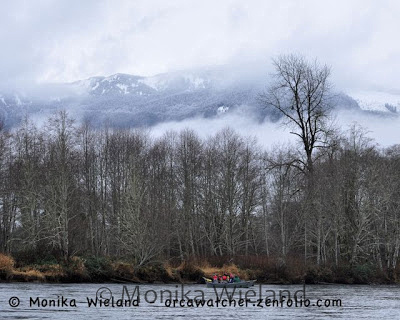
|
| Drift boat watching a bald eagle on the Skagit River |
During the first half of our trip we actually didn't see all that many eagles - maybe ten or so over the first couple miles. Eagle numbers apparently peaked this year in late December and have been rapidly falling since then. Even at their peak, they only had about half as many birds as last year. Getting spoiled by our booming bald eagle population in the San Juan Islands, I wasn't that impressed. Most of our views were of single birds high up in the trees, silhouetted against the sky.
We got out on a sand bar by a newly constructed beaver dam where salmon carcasses littered the beach, the bony remnants picked clean by the eagles and other creatures. Below the beaver dam several salmon redds were visible, where males had cleared out an area for the females to lay their eggs. They're visible here as the gray patches in the middle of the water:
For the second half of the trip, the eagle numbers started to really pick up. Some of the eagles were lower down, providing some better photographing opporunities. It was especially cool when a bird was perched on a branch overhanging the river and we were able to drift right under it, giving us a unique angle as we looked straight up at the eagle:
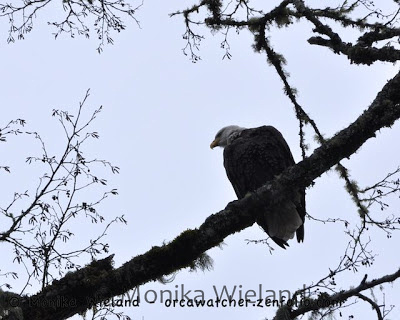
There were some much denser congregations of eagles. This stand of trees had nine eagles in it, seven of which are visible here:
In this same stretch of river I got my prize shot of the day:
This one isn't so bad either:
It's a pretty stunning landscape for photography, even on a gray dreary day. I wasn't the only photographer out to enjoy the eagles:
While I was a little underwhelmed from what I've seen and heard of other's trips to see the Skagit eagles, by the end of the trip we had seen about 70 eagles, which is still pretty amazing. I certainly haven't ever seen that many eagles in one day before.
The timing was perfect for us to catch the mid-afternoon ferry back to the island, which meant I got to bird a little bit from the ferry before it got dark. I was able to add the four expected species to the year list this way: pelagic cormorant (84), common murre (85), pigeon guillemot (86), and rhinoceros auklet (87). While it's not a given, I think this puts me in pretty good shape to reach 100 species before the month's end. We shall see!
]]>Being so close, we cruised by Vanport Wetlands, where the lighting was poor, but we were still able to turn up some ruddy ducks (70). At nearby Force Lake we weren't able to locate the recently reported palm warbler, but I did see a downy woodpecker (71). The great horned owl nest we've seen the last few years there appeared to be unused this year. The other notable sighting was four red tailed hawks soaring overhead.
From there it was onto Broughton Beach, where very cold and windy conditions kept us in the car. There were some California gulls (72) in the parking lot along with the glaucous-winged and ring-billed gulls, and we also found one common merganser (73) in the lee side of a houseboat taking shelter from the wind.
Our main destination for the day was Ridgefield National Wildlife Refuge, where we drove the S-River Unit. For the first half of the loop bird life was actually pretty sparse. Much of the refuge's water was still frozen over, meaning a lot of the waterfowl had moved elsewhere. One exception was the coot, who were mostly foraging in the marshy grasses, and would occasionally cross the ice to get from one foraging area to the next:
There were a lot of raptors around, too - we probably saw about 20 red-tailed hawks and half a dozen eagles, plus another half dozen or so northern harriers, like this one:
There were lots of nutria around, too. They would be more interesting to watch if they weren't so invasive:
On the far side of Rest Lake the bird life started picking up. We found a huge flock of song sparrows - probably 25 of them altogether. I don't think I've ever seen song sparrows flocking like that before. In among them was one savannah sparrow:
Behind the sparrows, hopping around on the grasses sticking up above the frozen waters, were about fifteen yellow-rumped warblers (74), the first year bird for the refuge coming about three-quarters of the way through the loop. While watching them a single tree swallow (75) also flew over. We started seeing more waterfowl over here, too, including huge flocks of cackling and Canada geese:
I was even able to snap this photo showing the two recently split species right beside each other:
I have actually never seen so many swans on the refuge. Some of them were congregating on the thawed middle part of the lake, and hundreds more were huddled together on the ice. We estimated they were probably about 1500 (!!) of them.
One of the red-tailed hawks we saw was a very pale Kreider's morph, and this one was unique too in that he seemed content to be sitting on the ground. He flew a couple of times and always landed on the ground again instead of one of the nearby trees or snags:
As we were trying to leave the refuge we got stuck behind a stopped train blocking the tracks we had to cross. The bright side of being stuck for a while meant we got to look closely at the river as we crossed the one-way bridge, having no where to go on the other side and no cross traffic to compete with. We added some double-crested cormorants and a belted kingfisher to our sightings list, as well as a pair of hooded mergansers (76).
Back at my parents' house on January 4th I finally saw a pine siskin (77) come to the feeder, and driving home from a dinner out with friends I got a huge surprise when I saw a tiny owl sitting in the road a few miles from my parents' house. Luckily it hadn't gone far when I turned around - it was sitting on the bank by the side of the road and let me shine my headlights on it. It looked right at me before taking flight a moment later, allowing me to identify it as a northern saw-whet owl (78)! This is a species I definitely did not expect to get on the year list. It's also the first time I've ever seen this bird; last year it was a life bird when I heard a couple of them calling while camping near Astoria.
Today, after an amazingly quick two weeks, it was time to start heading north back towards the San Juan Islands. On the way, I had to stop again at the Nisqually Reach Nature Center near Olympia where I had some good sightings on my way south. It was well worth the slight side trip as while standing in a single spot on the shoreline I quickly added five more year birds: a western gull (79), the same very distant snowy owl (80) across the river delta, one horned grebe (81), a flock of common goldeneye (82), and a couple of red-breasted mergansers (83).
Perhaps spoiled by last year's amazing snowy owl sightings at Boundary Bay, I wasn't quite content with the speck of a view of one through a scope at Nisqually. Being in no rush, we made another side trip near Ballard to look for the snowy owls that have somewhat oddly been hanging out right in an urban neighborhood not far from downtown Seattle. Luckily the neighbors and local dog walkers are very friendly to the "owl people" and they pointed us in the right direction. We spotted one of the two that have been hanging out in the same few block area since before Thanksgiving. I wonder what they're eating?
Tomorrow, it's time to head home and get ready to get back to work and the regular routine on the island. First, we've got one more overnight away and hopefully a little more birding to do tomorrow before catching our ferry....
]]>Just like last year, when I awoke on New Year's Day I added the same first species to my year list without opening my eyes as I heard a Steller's jay (1) in my parents' yard. I went downstairs and ate a bowl of cereal in front of the sliding glass door overlooking the beautiful, snow-dusted landscape, every bough and branch looking like it had been dipped in ice. I added seven more species to the list, most of them the same ones that made up my first ten species from last year: black-capped chickadee (2), mourning dove (3 - was 30 last year), chestnut-backed chickadee (4), red-breasted nuthatch (5), dark-eyed junco (6), spotted towhee (7), and song sparrow (8).
We took off towards Saint Helens, passing ten species with the American crow (10) and adding a few others on our way to the Honeyman Road loop that goes through Scappoose Bottoms. Along the way we had to stop to take a few pictures not only of birds but of the snowy landscape, too:
The reservoir on Honeyman Road had at least 50 tundra swans (16) on it, a species it was nice to add so early and one that wasn't present when we had visited shortly before. Just down the road from the swan overlook was my first red-tailed hawk (17) of the year. My camera settings weren't quite right when it took flight, but I like the result in this photograph anyway:
The rough-legged hawk wasn't in his usual corner, so we thought that might be a big miss. There were other raptors around, however, including a bald eagle (20), several American kestrels (21), and a northern harrier (23). Kestrels are often quite skittish, but this one didn't move when we slowed the car down below it. It wasn't until I looked at the photo that I realized he was clutching a mouse, with blood on his beak and feathers and dripping down the pole. Such is the life of a bird of prey:
We found the rough-legged hawk (24) further down the road form his usual hang out - yay! The rest of Honeyman Road turned up our first bunch of waterfowl and three gull species, with some highlights being half a dozen Wilson's snipe (28) and a small flock of sandhill cranes (29).
The weather was crisp but it was time to get out and walk part of the Crown-Zellerbach trail. The Ross' goose from a few days before was no where to be seen, but in its place were six snow geese (35) with a huge flock of cackling geese. More of the regular wetland species were added here, most notably a Virginia rail (42) that responded to a played vocalization, one or two marsh wrens (43), and a lone cinnamon teal (46). There weren't as many sparrows and small birds in the blackberry bushes, perhaps due to all the people out walking their dogs and enjoying the sunny first day of the year. One dog walker even stopped and asked to take a picture of us crazy birders for the county webpage. Several others stopped to share their own bird sightings with us, even if it was just "a flock of 50 starlings". It's always nice to get others to think about the birds they've seen!
We drove along Dike Road next where the highlight was a male Eurasian wigeon (51), a species that eluded both me and my dad last year. From there it was a short drive to Sauvie Island, where the first stop was to enjoy a pair of peregrine falcons (54) perched in perfect lighting:
Last year, I didn't add peregrine falcon until #218 in October. These two were on adjacent poles, and then one flew to join the other, setting up this great photo op of a pair of falcons, each facing different directions:
It was hard not to stop and take another picture of the same photogenic cows, especially because of the flock of Brewer's blackbirds (55) in their field.
The next pasture over were some very strange looking llamas. They're carrying quite the load of wool, which looks so unkempt as to be growing its own layer of moss of algae:
From there it was on to the Reeder Road observation blind. The duck composition had changed quite a lot from a few days before, perhaps in part because of all the hunting that was going on nearby. We actually saw one guy across the marsh shoot and then wade out to net a duck or goose, the poor thing still struggling as he made his way back to shore. It was interesting to have lots of bird watchers with scopes and binos on one side of the lake and hunters with guns poking through blinds right across the way on the other side. Most of the birds were American coot, and gone from what we could tell were the ruddy ducks, but we did re-find the redhead (58) and canvasback (59), as well as a single female bufflehead (60) and some lesser scaup (61).
With getting a later start than planned and taking our time everywhere we went, we realized we weren't going to cover nearly as much ground as we had originally planned for January 1. Still, without traveling nearly as far as we did last year, we equaled last year's first day of the year total by about 2:30 in the afternoon. Next up was Rentenaar Road, where we had seen the Harris' sparrow on the 29th. It looked like lots of other birders had the same idea, as the road was busy from end to end. As we pondered what it was about this particular dirt road edged with blackberries that so attracted sparrows, we saw dozens of golden-crowned and white-crowned sparrows (63). All in all, we only turned up four of the seven sparrow species from a few days before. We managed to turn up two Lincoln's sparrows (64), but no Harris' sparrow for us that day.
By this time the annoying cold that has greeted me this new year was beginning to take its toll on me, so we started to head home. On our way off the island we picked up double-crested cormorants (65) as expected, but didn't see any of the hoped-for mergansers along the Multnomah Channel.
As we reviewed the first day of birding, we agreed the peregrine falcons were the highlight, but were surprised that fox sparrow hadn't made it onto the list - last year it was #10 for me. On our way home we went by a patch of bushes where we had seen a pair of fox sparrows a few days ago. They hadn't been there in the morning, but amazingly to me, there they were in the afternoon (66). Just like the rough-legged hawk and so many other birds, they astound me with their site fidelity. Since we were so close we returned to the rough-legged hawk area, a spot known to some birders as Owl Corner. While the rough-legged hawk had returned to his usual perching tree, there were no short-eared owls or any other kind of owls to be seen patrolling the fields.
That proved to be it for day one, but with an improvement of five species over last year, I was pleased enough. I perhaps paid for being out and about so much with a cold coming on, as I proved to be totally down for the count today and further birding plans had to be postponed. The only species I added on day two were evening grosbeaks (67) and varied thrushes (68) that came to my parents' feeders, seen comfortably from under a blanket on the couch. I hope to still get in a trip to Ridgefield National Wildlife Refuge before I leave, and hopefully seek out a couple of the rarer birds reported in Portland recently on the way there.
]]>On Saturday we headed to Sauvie Island, where the first major attraction wasn't avian but mammalian, and not wild but domestic:
These cows were quite interested in us, and quite photogenic:
We looked high and low for a merlin, a big miss on the year list for both me and my dad. We did see probably a dozen American kestrels, and at least as many red-tailed hawks:
We stopped at the Reeder Road observation platform where there were great numbers and variety of waterfowl. Some highlights included a canvasback, a redhead, and two female ruddy ducks, as well as most of the other unexpected duck species. Again I crossed my fingers in hopes the same birds would be present on New Year's Day.
Next stop was Rentenaar Road, where the Harris' sparrow had been reported. As I mentioned, we found the Harris', and an amazing six other sparrow species: song, white-crowned, golden-crowned, fox, Lincoln's, and savannah. We later heard some other birders also found a swamp sparrow and a clay-colored sparrow. At the end of the road we also saw a huge flock of snow geese. One other notable sighting on Sauvie Island was the amazing number of sandhill cranes - 300 is probably a conservative estimate of what we saw.
On Sunday morning "the mountains were out" as they say during a clear day in the Portland area. From Scappoose Bottoms we could see Mt. Hood, Mt. Adams, and Mt. Saint Helens. Here's a couple views of Saint Helens - the first one with a great egret and the second one with an American coot:
Along the Crown-Zellerbach trail, we scouted out some great birds that I hoped would be around on January 1, including the Virginia rail, red-breasted sapsucker, and yellow-rumped warbler.
Later that day I got to visit the neighbor's chickens, where this handsome fellow wouldn't qualify for a year list but was still fun to see and photograph:
That recaps the last birding of 2012, so next post will be about kicking off the year list for 2013, which I did today. We didn't have a white Christmas here in Columbia County, Oregon, but snow slowly fell for much of New Year's Eve, so we welcomed in the new year in wintery style. Photos of that in the next post too!
When I started keeping a year list in 2010 I traveled up the Alaska Highway, so it's no surprise that that remains my highest annual total with 233 species. With trips this year to California and Utah, I was able to pass my 2011 total of 206 by tallying 222 species on the year. Here's my updated table comparing the three years:
2010 | 2011 | 2012 | |
Total # Bird Species | 233 | 203 | 222 |
Dave's Total | 237 | 206 | 275/205* |
Dad's Total | 230 | 204 | |
# States/Provinces | 6 | 4 | 5 |
# Life Birds | 23 | 3 | 6 |
# SJ County Species | 133? | 157 | 145 |
# Species by Month | |||
January | 87 | 114 | 105 |
February | 19 | 13 | 52 |
March | 25 | 12 | 3 |
April | 21 | 25 | 12 |
May | 37 | 17 | 24 |
June | 24 | 2 | 14 |
July | 1 | 4 | 0 |
August | 2 | 4 | 3 |
September | 3 | 5 | 0 |
October | 2 | 1 | 6 |
November | 4 | 4 | 0 |
December | 8 | 2 | 3 |
The February trip to California boosted that month's total by a lot this year, and as a consequence there were fewer spring migrants to add in March and April. I also always like to try and tally at least one year bird in every month of the year, and this is the first year that I failed to do that. Looking at the monthly comparison over the last three years, it's apparent how my busy work schedule from July through December influenced my time to go birding.
I also have a friendly competition with Dave from England, who has edged me out by a few species in both the previous years. This year, taking into account the 70 species he saw on a trip to Australia, he crushed me 275 to 222. If you look at only his Europe list and compare it to my only North America list, I beat him for the first year 222 to 205. My dad also kept a year list for the second year in a row. He fell short of his goal of 250 species, so I beat his year list for the first time, too.
Here are some bird highlights of the year 2012:
Here are some bird highlights of the year 2012:
- Our first day of birding on January 1, 2012 turned up 61 species in the greater Portland area. Will be able to reach that total on January 1, 2013?
- In January I traveled to Boundary Bay near Vancouver, BC to see the snowy owls that were congregating there. I saw an amazing 21 snowy owls, and they became my 91st species of the year, compared to species #200 in 2011.
- During my first COASST survey of 2012, I was able to get a photograph of five shorebird species in the same frame on Fourth of July Beach on San Juan Island.
- Our trip to Pismo Beach, California in February was awesome for a lot of reasons, but the memory that will always stand out to me the most was visiting the butterfly garden and seeing not only thousands of Monarch butterflies but lots of great birds, including red-shouldered hawks and my first life bird of the year, a Nuttall's woodpecker.
- In April I got to visit Three Meadows Marsh on San Juan Island for the first time. This private wetlands is an amazing waterfowl habitat, and I also added some first of the year spring birds while there. On the way to visit the marsh, I also saw and photographed a western kingbird, an uncommon species for the island.
- In May Katie and I discovered that the owl hole near her house was in fact a nest, and we saw the chicks for the first time.
- In June I got to help band baby bluebird chicks, and I also went to Winthrop, Washington for the first time, where the birding was amazing. Pipestone canyon turned up species such as sooty grouse, canyon wren, and prairie falcon, and I also added a couple more life birds: red-naped sapsucker and Williamson's sapsucker.
- Our October trip to Utah didn't turn up as many year birds as I had hoped, but I did add a loggerhead shrike and rock wren to the list, reaching my goal of 215 species on the year.
Due to the low light conditions I thought I'd try to catch some images of birds in motion, and my first opportunity was this rough-legged hawk in flight:
He/she then perched in a nearby field. After scanning with the binos we found a second rough-legged hawk, the first time my dad has seen two in this area together. There were also an amazing number of red-tailed hawks, probably at least a dozen in the ten-mile loop, including a pair nearby the rough-leggeds. While we watched the raptors several hundred cackling geese flew overhead, cackling away the whole time.
Along the next stretch of road we saw some western meadowlarks - a good find that I hope we turn up again on New Year's Day. We also found lots of dark-eyed juncos and a couple flocks of golden-crowned sparrows, and a few song and fox sparrows. One field had eight great egrets, and we also saw a couple of great blue herons. There was a belted kingfisher who was looking for fish in a flooded ditch. Check out how steep his dive was off the branch:
Another red-tailed hawk was perched on a nest, maybe preparing it for the upcoming breeding season:
The low hanging stratus clouds and flooded farm fields made for some neat scenics, like this one:
Our last stop of the day turned out to be a surprisingly productive one. In addition to hundreds of cackling geese, there were several hundred gulls. At least three species were present - most of them seemed to be mew gulls, but there were also glaucous-winged and ring-billed. Several duck species were in the middle of the flooded field, and at the edge of the marshy area we spotted six greater yellowlegs, another species that it would be great to repeat on the 1st. The real coup, however, turned up when I spotted something white among the cackling geese. We thought it was probably a gull at first, but after a closer inspection it turned out to be a Ross' goose (221)! One more year bird for the list, one that has eluded me the last couple of years.
That's likely all that will be added to the year list (I said that once before, didn't I?) unless something very unexpected turns up at my parents' feeders in the next couple of days. We'll see!
]]>Yesterday I headed down to Portland for the holidays, making a stop at Nisqually Widlife Refuge along the way. Amazingly, despite pouring rain both before and after my stop there, the sun actually came out for a bit of a walk. My parents met me there and our first stop was the Nisqually Reach Nature Center near the river delta, where through my dad's scope we were able to spot one very distant snowy owl. There have been a lot of snowy owl sightings throughout the region again over the last month, and I'm hopeful Boundary Bay turns out to be a great spot again near Vancouver, BC sometime in the next month, because I would definitely be up for another trip there. We also spotted four brant (220), which will perhaps be my last year bird in 2012, making for a nice even number. There were also some western gulls, surf scoters, and common goldeneye on the water.
We also walked the Twin Barn Loop over at the main part of the refuge:
We also walked the Twin Barn Loop over at the main part of the refuge:
We mostly saw lots of waterfowl here, including hundreds of cackling geese, plus American wigeon, northern shoveler, Canada geese, gadwall, ring-necked ducks, mallards, American coot, and northern pintail. The most impressive sight, however, was probably the clouds:
Which also made for some pretty neat reflections:
There were quite a few raptors about, too. We saw two red-tailed hawks, one or two harriers, and six bald eagles. Five of the eagles were all perched together in the same tree overlooking the river. It reminded me of all the bald eagles that congregate in January and February also the Skagit River closer to home, something I'm going to be sure to check out early next year. First up, though, it's time to review the 2012 year list and kick of the 2013 year list in Oregon on New Year's Day. Look for those posts in the near future!
Also in this area we found some western meadowlarks, a northern harrier, and a pair of bald eagles. Next we continued on towards Cattle Point, stopping to take a look at this red fox in its beautiful winter coat:
There were also four deer on the hillside of Mt. Finlayson, and when the sun came out I had to stop and take this photo of two of them:
At Cattle Point the highlight was a flock of about 30 black turnstones that landed on the rocks right below us. It was cool to look down on them chittering away as the waves crashed over the rock they were standing on. All the other usual sea bird species were around too, including surf scoters, harlequin ducks, a black oystercatcher, horned grebes, and red-breasted mergansers. We also saw a red-tailed hawk and a flock of about 200 starlings doing amazing aerial formations.
Next stop was Fourth of July Beach for a COASST survey. There weren't any stranded seabirds, but there were plenty more good bird sightings. The highlight for me was all the shorebirds, including another twenty or so turnstones, half a dozen black-bellied plovers, and two dunlin. There were also some song sparrows and Pacific wrens darting in and out among the driftwood.
Today we decided to bird more of the interior of the island. Our first stop was Sportsman Lake where we found several trumpeter swans, about 20 hooded mergansers, a good number of ring-necked ducks, and a few bufflehead, pied-billed grebes, double-crested cormorants, and American wigeon. There was also one common merganser. We next swung by Egg Lake, where there were a few more swans and a nice group of American coot. Here's the view across the dock at Egg Lake:
We continued out towards Roche Harbor and drove the White Point Road loop which takes you right down to the water of Wescott Bay. There were a few red-breasted mergansers here, so we got to see all three merganser species on the day. I also spotted two horned grebes and a pigeon guilemot. The reflections of the cumulus clouds in the calf waters were probably the most stunning sight at this stop:
It wasn't much further down the road that we stopped to view six California quail that were hanging out near the road. Often skittish, these guys were more accommodating, hanging out for a while as we took photos from the car:
Also on this stretch of road we found a big flock of pine siskins. It was pretty quiet bird-wise at the lagoon near Roche Harbor except for a couple of ravens and a kingfisher, but before heading back to town we made one more stop at the ponds south of British Camp which are often good for ducks this time of year. They didn't disappoint! We saw more swans, Canada geese, and a group of 11 greater white-fronted geese, only the second time I've seen this species on the island. In addition to a lot more ring-necked ducks, bufflehead, and wigeon, there were also our only mallards of the day, a pair of northern shoveler, and one more common merganser. With only a couple hours birding each day, we turned up more than 50 species on the weekend - not bad!
]]>My most popular yearly product is always my annual Southern Resident calendar. My 2013 calendar features pictures all taken during the 2012 season, so if you've gotten one of my calendars in the past, you won't see any repeat images here. You can save 25% off your calendar, too, using coupon code CALENDARTIME at check out!

2013 Southern Resident Killer Whale Calendar by OrcaWatcher
Browse more Orca Calendars
J1 Ruffles was one of the most iconic and popular of the Southern Residents. I made this Christmas ornament honoring him when he went missing in 2010:
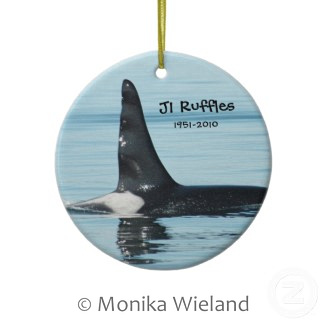
J1 Ruffles Tribute Ornament by OrcaWatcher
More Orca Ornaments
Here's another ornament featuring a breaching orca. Order one of each (or any two ornaments) and save 25% using coupon code TWOORNAMENTS
My most popular photo has long been this image, entitled "You'll Never Swim Alone". It features the calf K42 Kelp, his mom K14 Lea, and elder female J8 Spieden. Enjoy it as a poster or canvas print:
My most popular photo has long been this image, entitled "You'll Never Swim Alone". It features the calf K42 Kelp, his mom K14 Lea, and elder female J8 Spieden. Enjoy it as a poster or canvas print:

You'll Never Swim Alone Posters by OrcaWatcher
Browse for more artwork prints
I've also got a series of iPhone, iPad, and iPod cases available. Here's a new one for an iPhone 5 featuring a spyhop from J27 Blackberry:

Spyhopping Orca iPhone Case by OrcaWatcher
View more Orca Casemate Cases
If it's been a while since you've been on Zazzle, they've added lots of new great products recently. Here's one of my favorites, journals:

Sunset Orca Journal Notebook by OrcaWatcher
Browse other Orca Notebooks
And here's another simple one that I like, notepads:

Spyhopping Orca Notepad by OrcaWatcher
Browse Orca Notepads
Thanks for taking the time to look, and I would be honored if any of these products would make great gifts for anyone on your holiday list. Even if you don't purchase from me, take a moment to look around at all the great artwork featured on Zazzle, or maybe even create some products of your own!
J48 was the fifth offspring born to J16 Slick. The calf was first seen in December 2011 and was missing the next month. I didn't get to meet this little whale, who in addition to mom left behind three surviving siblings: J26 Mike, J36 Alki, and J42 Echo.
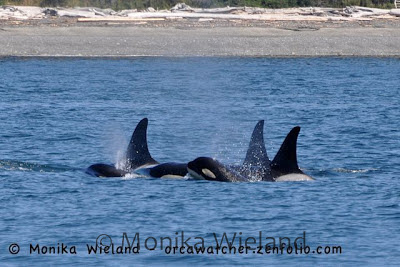
|
| L112 Sooke, born 2009, seen here with L47 Marina, L86 Surprise, and L91Muncher |
The death of L112 Sooke remains particularly sad and mysterious. I documented her story in detail in a separate blog post. She washed up on a beach in Long Beach, Washington in February 2012 with blunt force trauma. The exact cause of her death has not been determined, but a necropsy showed that her wounds were not consistent with a ship strike or predation event. Following her death, activities of both the US and Canadian Navy received a lot of scrutiny, from underwater sonar testing to the bomb range that exists off the Washington coast. Hopefully, the result of all this is that additional precautions be put in place to protect this endangered population of whales from underwater noise and explosions that could lead to permanent injury and death. In the near future her skeleton will be on display at The Whale Museum in Friday Harbor. It is always sad to lose a whale, particularly a young whale, but even more so a young female. L-Pod does not have many juvenile females, without which this population has no chance of recovery. Sooke was one of the few.
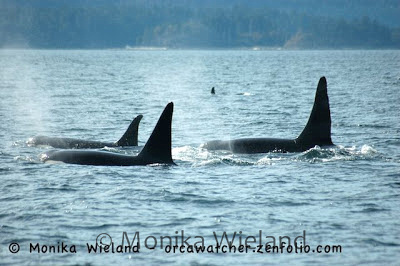
|
| J30 Riptide, born 1995, seen here with L53 Lulu and J1 Ruffles |
I was shocked when I heard that J30 Riptide had not been seen this spring. J-Pod has always seemed like the most resilient of the three pods, but Riptide is the second young adult male in the pod to die prematurely in recent years (the other was J33 Keet in 2010). Riptide was the second known offspring of J14 Samish and despite being just 16 years old already had a huge dorsal fin that was nearly fully grown. One of the very first pictures I took of Riptide shows him with J1 Ruffles, and the two proved to be regular companions over the years until the death of Ruffles. That's why I chose to honor him with the above picture, showing the two males together in Boundary Pass several years ago. I imagine Riptide must have been learning a lot from the oldest male among the Southern Residents, and it's a shame he won't be able to put the knowledge to use as a breeding adult male. Riptide is the probable great grandson of J2 Granny and also leaves behind three younger siblings.
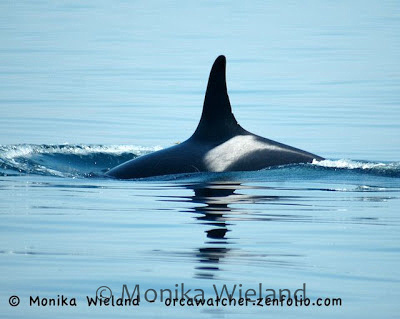
|
| L12 Alexis, estimated birth year 1933 |
At an estimated age of 79, Alexis lived the long, fruitful life of a matriarch resident whale. She's the namesake for the L12 subgroup, a well-known portion of L-Pod that tends to spend a lot more time in inland waters than the rest of the Ls. Her strong ties throughout her life with the L28 and L32 matrilines seems to be a key reason these three families travel together so much of the time. She was often associated with both of these mothers as well as with their offspring, and late in her life seemed to have become the adopted mom of L85 Mystery, the son of L28 Misky. The probable grandmother of the iconic male L41 Mega, Alexis, like Mega, also had two notches on her dorsal fin that made her distinct. Earlier this year I wrote a creative piece imagining a day in the life of Alexis where she was surrounded by her extended family. A mainstay throughout my whale watching years and well before that, I had no idea I would never see her again.
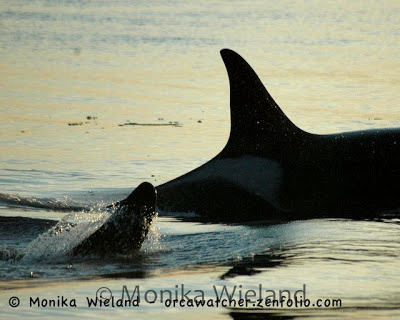
|
| L5 Tanya, estimated birth year 1964, seen here with her son L73 Flash diving beside her |
Unlike Alexis, L5 Tanya was part of a group of L-Pod whales that does not spend a lot of time in inland waters. As such, I never got to see too much of her, and was always excited when I did as she remained a more unknown whale to me. She only had two known offspring, both sons, and both very distinct males. L58 Sparky was one of the first few whales I learned to identify around the year 2000. He was easy to pick out because this was a time when there were only 3 or 4 fully adult males in the whole population. Her other son, L73 Flash, was a bit of a Ruffles lookalike. Unfortunately both sons preceded Tanya in death. Tanya had a bit of a unique dorsal fin, at least to my now more highly trained eye. The middle of the back trailing edge seemed to bulge out, easily seen in the above photograph where she is silhouetted. She also had a distinct line across one of her saddle patches, and a testament to how rarely I saw her is the fact that I never got a great picture showing this unique marking very well. With her passing, Tanya leaves behind young male L84 Nyssa, her sister's grandson, as the only surviving member of the L9 matriline.
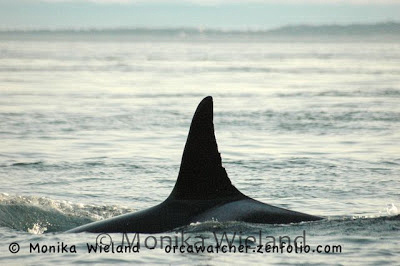
|
| K40 Raggedy, estimated birth year 1963 |
Raggedy! I still can't believe you are really gone. Talk about a whale with a unique history, of which we only know a very small piece. One of the unknown parts is how she got all those notches that made up the tattered trailing edge of her dorsal fin. I first learned about Raggedy's interesting family when I wondered how she was already numbered the 40th whale in K-Pod when at the time there was no K39, K38, K37, and so on. It turns out this is because she, along with the rest of her family group, were originally designated as L-Pod whales. Before 1977 they were always seen with L-Pod. Then, between 1977 and 1981 they started being seen with Ks, and after 1981 were almost always seen with Ks. Michael Bigg suspected they might be Ks due to their acoustic call types, and in 1986, coinciding with the birth of K21 Cappuccino into this family group, the switch from L to K was officially announced, the only time any whales have had their pod designation changed.
Raggedy's family was our first clue that matrilines are probably more stable than pods, as we've seen other whales and groups of whales seemingly shift pod associations for both short and long lengths of time. While there is a genealogy written out for this group of whales (the K18 and K30 matrilines), it seems the mother-offspring relationships have never really been clear as the family associations were reorganized several times. What is known is that Raggedy was never seen with a calf, leading to speculation that she was probably infertile.
One of my first-ever whale encounters was with Raggedy and her suspected mom, K18 Kiska, and probable brother K21 Cappuccino. I was aboard the Bon Accord in Haro Strait. The boat was parked as we watched a social multi-pod gathering milling about when we were surprised by three whales that popped up closer to us than all the rest: Kiska, Raggedy, and Cappuccino. This was the first time I had ever been this close to a wild whale, and the video camera I had rolling at the time recorded my frantic, excited comments as Raggedy surfaced right beneath me. "I got wet from the spray!" I called out in a shaky voice. "Oh my God!" There was no going back for me from that moment.
Raggedy leaves behind her stalwart companion Cappuccino. In recent years these two whales have often traveled between pods with K16 Opus and K35 Sonata, continuing the rogue ways of the family group. Early sightings indicate Cappuccino, Opus, and Sonata will carry on the unpredictable tradition in Raggedy's absence.
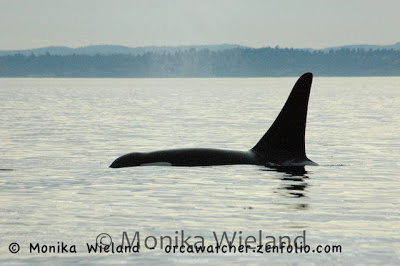
|
| L78 Gaia, born 1989 |
L78 Gaia is another whale from a very independent family group: the L2 matriline. At just 23 years old, it also feels like we lost Gaia way too early, but unfortunately he follows a trend of other L-Pod whales that we have recently lost in their 20s. Since 2008, the family group has just been made up of L78 Gaia, mom L2 Grace, and Gaia's younger brother L88 Wavewalker. The three whales were sometimes seen with no other Southern Residents. On one memorable day they were spotted near Lopez Island and initially identified as transients since there were only three of them, though this is a bit hard to believe since all three have distinct open saddle patches that transients never sport.
Gaia was the uncle of L98 Luna, the young whale who somehow got separated from his mom and spent years alone in Nootka Sound off the west side of Vancouver Island. In 2009 Gaia showed up with a wicked scrape on his dorsal fin, a wound so gruesome observers worried it could become infected. He seemed to heal up from this just fine, and it wasn't too long before he had just a faint scar on the front of his dorsal fin. I always thought of Gaia as having a very broad dorsal fin, one that will truly be missed by me among the other L-Pod whales.
So those are the whales we have lost this year - unnamed J48, Sooke, Riptide, Alexis, Tanya, Raggedy, and Gaia. We have had just two new arrivals in that time. L119, a girl, was born to L77 Matia, a calf I was very happy to hear about. Both Matia and her sister L94 Calypso had calves in 2010, but Matia lost hers, and I could only imagine what it was like for her as a bereaved mom to watch her younger sister with a healthy baby. It must have been very bittersweet. Now she has another little youngster of her own, which amazingly I never got to meet this summer. Perhaps an indicator of the shifting patterns as a result of Alexis' death (Matia and Calypso, along with Mega, are also her probable grandchildren), the L12s did not spend nearly as much time doing their regular westside shuffle off of San Juan Island this summer. I saw very little of this family group this year and look forward to seeing both sisters with their healthy calves next year.
The other birth was J49, a boy, born to J37 Hy'shqa. In a rare case of a Southern Resident being born in inland waters, we actually know the birthday of J49 is August 6th, and he was born somewhere around Turn Point on Stuart Island. With his birth, Hy'shqa became the youngest mother on record at just over 11 years old. I was worried about these two whales, since the other young mom I witness (K28 Raven was just 12 when she gave birth to K39 in 2006 ) both perished shortly thereafter. But so far, both mom and calf seem to be doing just fine, and Hy'shqa has lots of help from her extended family. J49 is the first grandchild to productive mother J14 Samish and is also the first great-great grandchild to J2 Granny.
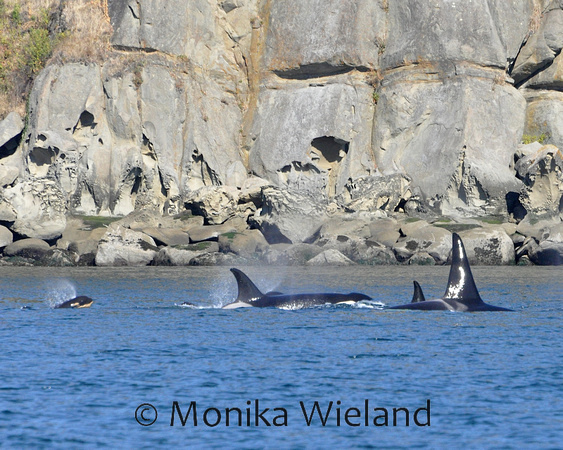
|
| J49, left, seen here at about six weeks old following behind grandmother J14 Samish and uncle J26 Mike |
This years births and deaths leave us at 84 whales in the Southern Resident Community. To the ones you have lost, you will be dearly missed, and to those that have arrived, we welcome you and hope you live to see the recovery of this endangered population.
Since I have a new-found appreciation for clouds, that makes this time of year a little bit more bearable; there are a lot of varied and changing cloud types to observe, which you don't see much of during the blue sky, fair weather days of summer. My prize "find" has been this Kelvin Helmholtz cloud. Some Kelvin Helmholtz clouds can be far more beautiful than this one, but they're a rare and fleeting cloud formation formed by a wind shear. They're the breaking waves of the cloud world, formed in the same way water waves are at the shoreline. The upper part of the cloud moves with a faster velocity than the lower part, creating the appearance of waves. It's fairly subtle in this photo, but you can see the cloud waves seem to be breaking from right to left:
The birding near Cattle Point has been fantastic. During one 1-hour excursion, I saw over 30 bird species. The raptors were probably the highlight, including two immature bald eagles (one seen sitting on the Cattle Point Lighthouse in the photo below), two northern harriers, a red-tailed hawk, a peregrine falcon (year bird 217), and a sharp-shinned hawk (218) harassing some starlings. Other notable sightings were a gull trying to eat a flounder, a Steller sea lion successfully eating a salmon while gulls swarmed above him, a snake, and the antics of a group of about five flickers as they flew about cackling at each other.
Another walk at third lagoon turned up a dozen surfbirds, and lots of woodland birds. I saw my first big winter flocks of golden-crowned kinglets, and there were also lots of red-breasted nuthatches, Pacific wrens, and dark-eyed juncos nearby. We also heard a couple of red crossbills.
I returned to Cattle Point, still hoping to see my first northern shrike of the year after missing them in the early 2012 winter months. I wasn't disappointed this time (219), as one flew up in front of me shortly after getting out of the car. That was all I would see of it, though down on the rocks below the lighthouse I was amused by seeing a harlequin duck hanging out right next to an immature black oystercatcher:
Also on this trip I saw three black turnstones, a flock of about 15 horned grebes, and three Pacific loons. A little bit inland from the coast were some mourning doves, an Anna's hummingbird, and a pair of cedar waxwings.
]]>When we got to Salt Lake City, we still had a few hours before we had to head to the airport so we went up Little Cottonwood Canyon towards Snowbird, a ski resort where my mom worked for a year in the early 70s shortly after my parents were married. The geology here was totally different than in southern Utah:
Since no snow has fallen yet (we did see a dusting in the higher hills on our drive after all the rain), the ski resort was still pretty quiet. A few people were around to enjoy the montane hiking trails and the remnants of the fall colors, which were already a little past their peak here. My dad saw a Clark's nutcracker, which unfortunately I missed. I walked around a bit here, at an altitude of about 8500 feet, but I only found a few Steller's jays and black-capped chickadees.
The rain held off while we were there, but the low cloud levels made for some pretty dramatic scenery. At lower elevations on our way down, we had to stop to take some pictures where the fall colors were still a little brigther:
That evening we caught our flight back to the northwest. It was raining, but at least there weren't any more thunderstorms that night!
]]>Early Thursday morning my dad and I went back to Arches for a sunrise, and we decided to watch from the Delicate Arch view point. It actually took quite a while from when the sun came up until it hit the arch, but it was still pleasant to sit quietly and watch the landscape change colors during the 90 minutes before and after sunrise. I even heard a canyon wren during that time! Here's the view from the upper viewpoint after the sun illuminated the arch:
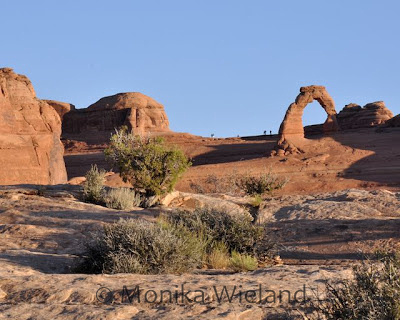
|
| Delicate Arch, as seen from the upper viewpoint |
After breakfast we drove to Canyonlands National Park. We only had time to visit the Island in the Sky region on this trip, but we had time to do several short hikes there and see all the major viewpoints. You enter the park on the top of a mesa, named the Island in the Sky because it is only connected to the surrounding land by a narrow strip known as "The Neck", and on all other sides drop the canyons into the Colorado and Green River valleys.
It's hard to imagine this land was once a flat plain; it is now divided into three different levels, each separated by about 1000 feet in elevation. We stood on the Island in the Sky, the next step down was the White Rim, and then below that the river gorges. The top level is the most moderate in climate, the middle level the driest and most desert-like, and the bottom level the most lush in terms of flora and fauna:
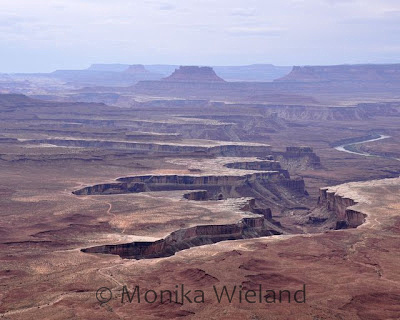
|
| View from the Green River Overlook |
One of the highlights of Island in the Sky is Upheaval Dome, which actually looks like a big crater with a mound (the dome) in the center. Both the rock structure and the erosion here are different than elsewhere in the Park, leading to several different theories as to its formation. Under one theory, the crater was formed by a salt dome, wherein salt buried from a former marine environment pushes its way to the surface. The second theory, which has been further bolstered by the most recent studies done in the area, is that it's actually an impact crater formed by a meteorite collision.
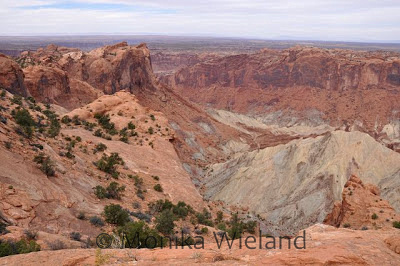
|
| Upheaval Dome |
We also took the short loop hike to see Mesa Arch, which was probably my favorite vista in the Park. There's a 500 foot drop off right below the arch, providing stunning panoramic views under the arch down into the surrounding canyons:

|
| Under Mesa Arch |
We got another look at the three tiers of Canyonlands from Grand View Point. I got a great book on the geology of Southern Utah at the Park visitor's center, so I'll probably do a couple of follow-up posts after reading that describing more how some of the amazing geological features we saw were formed. For now, do what I did, and just enjoy the view:

|
| Looking down from Grand View Point |
On our way out of the National Park we stopped at nearby Deadhorse Point State Park. The point here is also connected to the "mainland" only by a narrow neck, this one only 30 yards wide. This was actually our favorite canyon overlook of the day, looking down onto the winding Colorado River. We didn't get too lucky with the light at Canyonlands in terms of photography, and dark clouds continued to build while we were at Deadhorse Point. One ray of sunlight shone down onto the river, however:
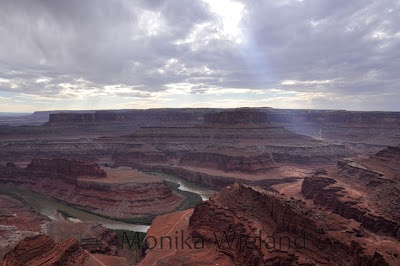
|
| Deadhorse Point |
The bird sightings continued to be sparse, but I did add a couple of year birds, too! I realized I never mentioned seeing some red-necked phalaropes (213) in the San Juans in late August, so the loggerhead shrike I saw at Arches National Park was year bird #214. Then, at the end of the Little Wild Horse Canyon hike, we saw a rock wren (215) in the wash, making that the species to bring me to my year goal of 215!
]]>The hike starts out by taking you a half-mile up a wash, where a few trees were showing some pretty fall colors:
You then climb up a dryfall, and shortly thereafter reach a fork leading to the entrances to Little Wild Horse and Bell Canyons. You can make an eight-mile loop out of the two canyons, but we chose to go part way up Little Wild Horse through the narrowest sections and then turn around and come back out the same way. You didn't have to walk too far until you were in between towering walls about a hundred feet high:
In some places the trail was about 10 feet wide, and in others in was less than shoulder width between the two canyon walls. Here's my mom to provide sense of scale - most of the trail was about like this:
In several areas some pieces of the wall had eroded creating an obstacle course to continue up the trail. There were lots of passable regions that took some creativity to navigate, like this one pictured below. It's amazing to me that the trail hasn't become impassable at some point by a huge rock falling down into it!
The walls contained lots of interesting geologic formations, like this:
It was a warm day, but the after entering the narrows the canyon was pleasantly cool. Still, there was very little wildlife or plant growth (at one point a raven soared by overhead), so I couldn't believe my eyes when a little bit of movement caught my eye and it turned out to be a red spotted toad (Anaxyrus punctatus):
This one must have been an immature because it was smaller than my ID pamphlet for the region listed it, meaning there must have been water somewhere nearby for these toads to breed this summer despite reports from the locals that they haven't had a drop of rain since July. These guys pass their days in rock crevices before becoming active at dusk, and can tolerate an amazing 40% loss of body water and still be active. They're also great climbers, which you had better be if you live in a rocky canyon and need to search for water!
The photos really hardly do the slot canyon justice, as it's something you have to experience to fully appreciate. But here's another one that tries, showing a more open section of the trail:
At one point I let everyone else walk ahead, taking a moment to run my hands over the cool, grainy sandstone and try to understand the time and natural forces that it takes to shape such an amazing place. It's hard to fathom.
Nearby Little Wild Horse was Goblin Valley State Park, and though we were tired we had to drive through to take a look. Am I ever glad we did!
It was initially named Mushroom Valley by Arthur Chaffin, the first European to find the valley in the late 1920s. I think this was a better name for it, since the formations look much more like mushrooms than goblins, but it was later re-named by the state of Utah. The bizarre formations are formed in a geological layer known as Entrada sandstone, the same rock level that forms the upper part of the arches in Arches National Park (the arches stand on a lower layer of rock known as the Carmel Formation, and fractures between the two layers lead to the beginning of arch formation). Here in Goblin Valley, fractures still create weaknesses within the Entrada sandstone. Where the fractures intersect, corners are created where erosion starts to occur. The edges continue to weather away faster than the remaining flat plains, eventually leading to the spherical mushroom shapes seen in the valley.
It's amazing how subtle differences in geology lead to such dramatically different formations. Specific conditions resulted to make so many arches in one location in the national park, and so many goblins here in one series of valleys in the state park. Here's a row of goblins that really shows their mushroom shape well:
It was another spectacular day in Southern Utah! But there was even more to come....]]>
